Let& #39;s HIT the topic  https://abs.twimg.com/emoji/v2/... draggable="false" alt="💊" title="Tablette" aria-label="Emoji: Tablette"> Heparin-induced Thrombocytopenia (HIT)
https://abs.twimg.com/emoji/v2/... draggable="false" alt="💊" title="Tablette" aria-label="Emoji: Tablette"> Heparin-induced Thrombocytopenia (HIT) https://abs.twimg.com/emoji/v2/... draggable="false" alt="🩸" title="Tropfen Blut" aria-label="Emoji: Tropfen Blut">!
https://abs.twimg.com/emoji/v2/... draggable="false" alt="🩸" title="Tropfen Blut" aria-label="Emoji: Tropfen Blut">!
This #tweetorial is a deep dive into Episode 43 of Run the List (RTL) on Thrombocytopenia: https://bit.ly/32feVfQ
Thanks">https://bit.ly/32feVfQ&q... @LeelaChock for covering this week’s topic!
This #tweetorial is a deep dive into Episode 43 of Run the List (RTL) on Thrombocytopenia: https://bit.ly/32feVfQ
Thanks">https://bit.ly/32feVfQ&q... @LeelaChock for covering this week’s topic!
Thrombocytopenia is a broad topic!
In Ep. 43 of RTL, Dr. Robert Stern, @NavinKumarMD, & @sonorato11 go over a general approach to thrombocytopenia https://abs.twimg.com/emoji/v2/... draggable="false" alt="👇" title="Rückhand Zeigefinger nach unten" aria-label="Emoji: Rückhand Zeigefinger nach unten">
https://abs.twimg.com/emoji/v2/... draggable="false" alt="👇" title="Rückhand Zeigefinger nach unten" aria-label="Emoji: Rückhand Zeigefinger nach unten">
Broadly, there are THREE umbrellas:
1. https://abs.twimg.com/emoji/v2/... draggable="false" alt="⬆️" title="Pfeil nach oben" aria-label="Emoji: Pfeil nach oben"> destruction
https://abs.twimg.com/emoji/v2/... draggable="false" alt="⬆️" title="Pfeil nach oben" aria-label="Emoji: Pfeil nach oben"> destruction
2. Splenic sequestration https://abs.twimg.com/emoji/v2/... draggable="false" alt="💪" title="Angespannter Bizeps" aria-label="Emoji: Angespannter Bizeps">
https://abs.twimg.com/emoji/v2/... draggable="false" alt="💪" title="Angespannter Bizeps" aria-label="Emoji: Angespannter Bizeps">
3. https://abs.twimg.com/emoji/v2/... draggable="false" alt="⬇️" title="Pfeil nach unten" aria-label="Emoji: Pfeil nach unten"> production
https://abs.twimg.com/emoji/v2/... draggable="false" alt="⬇️" title="Pfeil nach unten" aria-label="Emoji: Pfeil nach unten"> production
https://www.runthelistpodcast.com/s/RTL_Thrombocytopenia.pdf">https://www.runthelistpodcast.com/s/RTL_Thr...
In Ep. 43 of RTL, Dr. Robert Stern, @NavinKumarMD, & @sonorato11 go over a general approach to thrombocytopenia
Broadly, there are THREE umbrellas:
1.
2. Splenic sequestration
3.
https://www.runthelistpodcast.com/s/RTL_Thrombocytopenia.pdf">https://www.runthelistpodcast.com/s/RTL_Thr...
HIT (Heparin-induced thrombocytopenia), is classified under “ https://abs.twimg.com/emoji/v2/... draggable="false" alt="⬆️" title="Pfeil nach oben" aria-label="Emoji: Pfeil nach oben"> destruction”
https://abs.twimg.com/emoji/v2/... draggable="false" alt="⬆️" title="Pfeil nach oben" aria-label="Emoji: Pfeil nach oben"> destruction”
HIT in-depth:
 https://abs.twimg.com/emoji/v2/... draggable="false" alt="✨" title="Funken" aria-label="Emoji: Funken">It is *common*, occurring in 1 out of 5,000 hospitalized patients
https://abs.twimg.com/emoji/v2/... draggable="false" alt="✨" title="Funken" aria-label="Emoji: Funken">It is *common*, occurring in 1 out of 5,000 hospitalized patients https://abs.twimg.com/emoji/v2/... draggable="false" alt="✨" title="Funken" aria-label="Emoji: Funken">
https://abs.twimg.com/emoji/v2/... draggable="false" alt="✨" title="Funken" aria-label="Emoji: Funken">
 https://abs.twimg.com/emoji/v2/... draggable="false" alt="💥" title="Symbol für eine Kollision" aria-label="Emoji: Symbol für eine Kollision">It’s a can’t miss dx! 50% of patients w/ HIT who are not appropriately treated go on to develop a thrombosis
https://abs.twimg.com/emoji/v2/... draggable="false" alt="💥" title="Symbol für eine Kollision" aria-label="Emoji: Symbol für eine Kollision">It’s a can’t miss dx! 50% of patients w/ HIT who are not appropriately treated go on to develop a thrombosis https://abs.twimg.com/emoji/v2/... draggable="false" alt="💥" title="Symbol für eine Kollision" aria-label="Emoji: Symbol für eine Kollision">
https://abs.twimg.com/emoji/v2/... draggable="false" alt="💥" title="Symbol für eine Kollision" aria-label="Emoji: Symbol für eine Kollision">
HIT in-depth:
HIT risk factors?
 https://abs.twimg.com/emoji/v2/... draggable="false" alt="⬆️" title="Pfeil nach oben" aria-label="Emoji: Pfeil nach oben"> duration/dose of heparin administration (can even happen w/ simple heparin flush!)
https://abs.twimg.com/emoji/v2/... draggable="false" alt="⬆️" title="Pfeil nach oben" aria-label="Emoji: Pfeil nach oben"> duration/dose of heparin administration (can even happen w/ simple heparin flush!)
Type of heparin used: UFH > LMWH > fondaparinux https://abs.twimg.com/emoji/v2/... draggable="false" alt="💊" title="Tablette" aria-label="Emoji: Tablette">
https://abs.twimg.com/emoji/v2/... draggable="false" alt="💊" title="Tablette" aria-label="Emoji: Tablette">
 https://abs.twimg.com/emoji/v2/... draggable="false" alt="🩹" title="Pflaster" aria-label="Emoji: Pflaster">Surgical, trauma, cardiopulm bypass pts at
https://abs.twimg.com/emoji/v2/... draggable="false" alt="🩹" title="Pflaster" aria-label="Emoji: Pflaster">Surgical, trauma, cardiopulm bypass pts at  https://abs.twimg.com/emoji/v2/... draggable="false" alt="⬆️" title="Pfeil nach oben" aria-label="Emoji: Pfeil nach oben"> risk (maybe 2/2 increased heparin use, but MoA unknown)
https://abs.twimg.com/emoji/v2/... draggable="false" alt="⬆️" title="Pfeil nach oben" aria-label="Emoji: Pfeil nach oben"> risk (maybe 2/2 increased heparin use, but MoA unknown)
Patient sex (F>M)
Type of heparin used: UFH > LMWH > fondaparinux
Patient sex (F>M)
HIT mechanism:
 https://abs.twimg.com/emoji/v2/... draggable="false" alt="▶" title="Nach rechts zeigendes Dreieck" aria-label="Emoji: Nach rechts zeigendes Dreieck"> Heparin
https://abs.twimg.com/emoji/v2/... draggable="false" alt="▶" title="Nach rechts zeigendes Dreieck" aria-label="Emoji: Nach rechts zeigendes Dreieck"> Heparin  https://abs.twimg.com/emoji/v2/... draggable="false" alt="💊" title="Tablette" aria-label="Emoji: Tablette"> complexes w/ platelet factor 4 (PF-4), a protein released by platelets
https://abs.twimg.com/emoji/v2/... draggable="false" alt="💊" title="Tablette" aria-label="Emoji: Tablette"> complexes w/ platelet factor 4 (PF-4), a protein released by platelets
 https://abs.twimg.com/emoji/v2/... draggable="false" alt="▶" title="Nach rechts zeigendes Dreieck" aria-label="Emoji: Nach rechts zeigendes Dreieck"> B-cells make IgG antibodies (~5-7 days after heparin exposure) to the PF4-heparin complex
https://abs.twimg.com/emoji/v2/... draggable="false" alt="▶" title="Nach rechts zeigendes Dreieck" aria-label="Emoji: Nach rechts zeigendes Dreieck"> B-cells make IgG antibodies (~5-7 days after heparin exposure) to the PF4-heparin complex  https://abs.twimg.com/emoji/v2/... draggable="false" alt="🧪" title="Test tube" aria-label="Emoji: Test tube">
https://abs.twimg.com/emoji/v2/... draggable="false" alt="🧪" title="Test tube" aria-label="Emoji: Test tube">
 https://abs.twimg.com/emoji/v2/... draggable="false" alt="▶" title="Nach rechts zeigendes Dreieck" aria-label="Emoji: Nach rechts zeigendes Dreieck"> IgG then binds these heparin-PF4 complexes to platelets and then…
https://abs.twimg.com/emoji/v2/... draggable="false" alt="▶" title="Nach rechts zeigendes Dreieck" aria-label="Emoji: Nach rechts zeigendes Dreieck"> IgG then binds these heparin-PF4 complexes to platelets and then…
(HIT MoA cont.):
IgG-PF4-heparin complexes bind platelets causing BOTH:
 https://abs.twimg.com/emoji/v2/... draggable="false" alt="1⃣" title="Tastenkappe Ziffer 1" aria-label="Emoji: Tastenkappe Ziffer 1">Thrombocytopenia by marking the platelets for
https://abs.twimg.com/emoji/v2/... draggable="false" alt="1⃣" title="Tastenkappe Ziffer 1" aria-label="Emoji: Tastenkappe Ziffer 1">Thrombocytopenia by marking the platelets for  https://abs.twimg.com/emoji/v2/... draggable="false" alt="☠️" title="Totenkopf" aria-label="Emoji: Totenkopf">destruction
https://abs.twimg.com/emoji/v2/... draggable="false" alt="☠️" title="Totenkopf" aria-label="Emoji: Totenkopf">destruction https://abs.twimg.com/emoji/v2/... draggable="false" alt="☠️" title="Totenkopf" aria-label="Emoji: Totenkopf"> via splenic macrophages (type II hypersensitivity rxn)
https://abs.twimg.com/emoji/v2/... draggable="false" alt="☠️" title="Totenkopf" aria-label="Emoji: Totenkopf"> via splenic macrophages (type II hypersensitivity rxn)
AND
 https://abs.twimg.com/emoji/v2/... draggable="false" alt="2⃣" title="Tastenkappe Ziffer 2" aria-label="Emoji: Tastenkappe Ziffer 2">Paradoxical PRO-thrombotic state by IgG Ab complexes
https://abs.twimg.com/emoji/v2/... draggable="false" alt="2⃣" title="Tastenkappe Ziffer 2" aria-label="Emoji: Tastenkappe Ziffer 2">Paradoxical PRO-thrombotic state by IgG Ab complexes  https://abs.twimg.com/emoji/v2/... draggable="false" alt="💥" title="Symbol für eine Kollision" aria-label="Emoji: Symbol für eine Kollision">activating
https://abs.twimg.com/emoji/v2/... draggable="false" alt="💥" title="Symbol für eine Kollision" aria-label="Emoji: Symbol für eine Kollision">activating https://abs.twimg.com/emoji/v2/... draggable="false" alt="💥" title="Symbol für eine Kollision" aria-label="Emoji: Symbol für eine Kollision"> platelets!
https://abs.twimg.com/emoji/v2/... draggable="false" alt="💥" title="Symbol für eine Kollision" aria-label="Emoji: Symbol für eine Kollision"> platelets!
IgG-PF4-heparin complexes bind platelets causing BOTH:
AND
Sequelae include:
 https://abs.twimg.com/emoji/v2/... draggable="false" alt="🔴" title="Roter Kreis" aria-label="Emoji: Roter Kreis">Thrombocytopenia to ~50-80k (usually >20K)
https://abs.twimg.com/emoji/v2/... draggable="false" alt="🔴" title="Roter Kreis" aria-label="Emoji: Roter Kreis">Thrombocytopenia to ~50-80k (usually >20K)
 https://abs.twimg.com/emoji/v2/... draggable="false" alt="🟠" title="Orangefarbener Kreis" aria-label="Emoji: Orangefarbener Kreis">Paradoxical thrombosis (venous > arterial), despite thrombocytopenia!
https://abs.twimg.com/emoji/v2/... draggable="false" alt="🟠" title="Orangefarbener Kreis" aria-label="Emoji: Orangefarbener Kreis">Paradoxical thrombosis (venous > arterial), despite thrombocytopenia!
 https://abs.twimg.com/emoji/v2/... draggable="false" alt="🟡" title="Gelber Kreis" aria-label="Emoji: Gelber Kreis">(Rarely) anaphylaxis; HIT Ab may activate leukocytes
https://abs.twimg.com/emoji/v2/... draggable="false" alt="🟡" title="Gelber Kreis" aria-label="Emoji: Gelber Kreis">(Rarely) anaphylaxis; HIT Ab may activate leukocytes
 https://abs.twimg.com/emoji/v2/... draggable="false" alt="🟢" title="Grüner Kreis" aria-label="Emoji: Grüner Kreis">Skin necrosis at *heparin injection sites* (seen below) immediately suggests HIT!
https://abs.twimg.com/emoji/v2/... draggable="false" alt="🟢" title="Grüner Kreis" aria-label="Emoji: Grüner Kreis">Skin necrosis at *heparin injection sites* (seen below) immediately suggests HIT!  https://abs.twimg.com/emoji/v2/... draggable="false" alt="🩺" title="Stethoskop" aria-label="Emoji: Stethoskop">
https://abs.twimg.com/emoji/v2/... draggable="false" alt="🩺" title="Stethoskop" aria-label="Emoji: Stethoskop">
Let’s review timing  https://abs.twimg.com/emoji/v2/... draggable="false" alt="⏰" title="Wecker" aria-label="Emoji: Wecker"> of HIT!
https://abs.twimg.com/emoji/v2/... draggable="false" alt="⏰" title="Wecker" aria-label="Emoji: Wecker"> of HIT!
Suppose heparin is given on day 0:
 https://abs.twimg.com/emoji/v2/... draggable="false" alt="🔸" title="Kleine orangene Raute" aria-label="Emoji: Kleine orangene Raute">d0-d1 = Rapid 50% drop (pt already has IgG Ab 2/2 heparin exposure w/i last 3 months)
https://abs.twimg.com/emoji/v2/... draggable="false" alt="🔸" title="Kleine orangene Raute" aria-label="Emoji: Kleine orangene Raute">d0-d1 = Rapid 50% drop (pt already has IgG Ab 2/2 heparin exposure w/i last 3 months)
 https://abs.twimg.com/emoji/v2/... draggable="false" alt="🔹" title="Kleine blaue Raute" aria-label="Emoji: Kleine blaue Raute">d5-d7 = Rapid 50% drop (no prior heparin exposure)
https://abs.twimg.com/emoji/v2/... draggable="false" alt="🔹" title="Kleine blaue Raute" aria-label="Emoji: Kleine blaue Raute">d5-d7 = Rapid 50% drop (no prior heparin exposure)
 https://abs.twimg.com/emoji/v2/... draggable="false" alt="🔸" title="Kleine orangene Raute" aria-label="Emoji: Kleine orangene Raute">d7-d14 after heparin withdrawal = Rapid drop ("delayed-onset HIT")
https://abs.twimg.com/emoji/v2/... draggable="false" alt="🔸" title="Kleine orangene Raute" aria-label="Emoji: Kleine orangene Raute">d7-d14 after heparin withdrawal = Rapid drop ("delayed-onset HIT")
Suppose heparin is given on day 0:
If suspecting HIT calculate a "4-T score"
The 4 T& #39;s are:
 https://abs.twimg.com/emoji/v2/... draggable="false" alt="📌" title="Reißzwecke" aria-label="Emoji: Reißzwecke">Thrombocytopenia
https://abs.twimg.com/emoji/v2/... draggable="false" alt="📌" title="Reißzwecke" aria-label="Emoji: Reißzwecke">Thrombocytopenia
 https://abs.twimg.com/emoji/v2/... draggable="false" alt="📌" title="Reißzwecke" aria-label="Emoji: Reißzwecke">Timing
https://abs.twimg.com/emoji/v2/... draggable="false" alt="📌" title="Reißzwecke" aria-label="Emoji: Reißzwecke">Timing  https://abs.twimg.com/emoji/v2/... draggable="false" alt="⌚️" title="Armbanduhr" aria-label="Emoji: Armbanduhr"> of Onset
https://abs.twimg.com/emoji/v2/... draggable="false" alt="⌚️" title="Armbanduhr" aria-label="Emoji: Armbanduhr"> of Onset
 https://abs.twimg.com/emoji/v2/... draggable="false" alt="📌" title="Reißzwecke" aria-label="Emoji: Reißzwecke">Thrombosis
https://abs.twimg.com/emoji/v2/... draggable="false" alt="📌" title="Reißzwecke" aria-label="Emoji: Reißzwecke">Thrombosis
 https://abs.twimg.com/emoji/v2/... draggable="false" alt="📌" title="Reißzwecke" aria-label="Emoji: Reißzwecke">oTher causes of Thrombocytopenia.
https://abs.twimg.com/emoji/v2/... draggable="false" alt="📌" title="Reißzwecke" aria-label="Emoji: Reißzwecke">oTher causes of Thrombocytopenia.
A LOW score (<4 points) has a very HIGH negative predictive value (NPV) of 97 to 99%, and essentially *rules out* HIT
The 4 T& #39;s are:
A LOW score (<4 points) has a very HIGH negative predictive value (NPV) of 97 to 99%, and essentially *rules out* HIT
The positive predictive value (PPV) of a 4-T score of 4-5 is 10-20%, but a score >=6 is 40-80%
A 4-T score >=4 requires:
 https://abs.twimg.com/emoji/v2/... draggable="false" alt="1⃣" title="Tastenkappe Ziffer 1" aria-label="Emoji: Tastenkappe Ziffer 1">Stopping all heparin products immediately
https://abs.twimg.com/emoji/v2/... draggable="false" alt="1⃣" title="Tastenkappe Ziffer 1" aria-label="Emoji: Tastenkappe Ziffer 1">Stopping all heparin products immediately  https://abs.twimg.com/emoji/v2/... draggable="false" alt="🛑" title="Stop sign" aria-label="Emoji: Stop sign">!
https://abs.twimg.com/emoji/v2/... draggable="false" alt="🛑" title="Stop sign" aria-label="Emoji: Stop sign">!
 https://abs.twimg.com/emoji/v2/... draggable="false" alt="2⃣" title="Tastenkappe Ziffer 2" aria-label="Emoji: Tastenkappe Ziffer 2">An Anti–PF4–heparin ELISA test
https://abs.twimg.com/emoji/v2/... draggable="false" alt="2⃣" title="Tastenkappe Ziffer 2" aria-label="Emoji: Tastenkappe Ziffer 2">An Anti–PF4–heparin ELISA test  https://abs.twimg.com/emoji/v2/... draggable="false" alt="🧪" title="Test tube" aria-label="Emoji: Test tube">
https://abs.twimg.com/emoji/v2/... draggable="false" alt="🧪" title="Test tube" aria-label="Emoji: Test tube">
 https://abs.twimg.com/emoji/v2/... draggable="false" alt="3⃣" title="Tastenkappe Ziffer 3" aria-label="Emoji: Tastenkappe Ziffer 3">Starting therapeutic NON-heparin anticoagulation (e.g. Argatroban
https://abs.twimg.com/emoji/v2/... draggable="false" alt="3⃣" title="Tastenkappe Ziffer 3" aria-label="Emoji: Tastenkappe Ziffer 3">Starting therapeutic NON-heparin anticoagulation (e.g. Argatroban  https://abs.twimg.com/emoji/v2/... draggable="false" alt="💊" title="Tablette" aria-label="Emoji: Tablette">)
https://abs.twimg.com/emoji/v2/... draggable="false" alt="💊" title="Tablette" aria-label="Emoji: Tablette">)
A 4-T score >=4 requires:
Anti-PF4 test has high NPV (98-99%), but low PPV
a https://abs.twimg.com/emoji/v2/... draggable="false" alt="➕" title="Fettes Pluszeichen" aria-label="Emoji: Fettes Pluszeichen"> anti-PF4 result requires confirmation w/ *gold standard functional test*: serotonin release assay (SRA)
https://abs.twimg.com/emoji/v2/... draggable="false" alt="➕" title="Fettes Pluszeichen" aria-label="Emoji: Fettes Pluszeichen"> anti-PF4 result requires confirmation w/ *gold standard functional test*: serotonin release assay (SRA)
How does SRA work?
If pt& #39;s serum has active heparin-PF4 IgG Ab https://abs.twimg.com/emoji/v2/... draggable="false" alt="➡️" title="Pfeil nach rechts" aria-label="Emoji: Pfeil nach rechts"> activate donor platelets
https://abs.twimg.com/emoji/v2/... draggable="false" alt="➡️" title="Pfeil nach rechts" aria-label="Emoji: Pfeil nach rechts"> activate donor platelets  https://abs.twimg.com/emoji/v2/... draggable="false" alt="➡️" title="Pfeil nach rechts" aria-label="Emoji: Pfeil nach rechts">
https://abs.twimg.com/emoji/v2/... draggable="false" alt="➡️" title="Pfeil nach rechts" aria-label="Emoji: Pfeil nach rechts">  https://abs.twimg.com/emoji/v2/... draggable="false" alt="💥" title="Symbol für eine Kollision" aria-label="Emoji: Symbol für eine Kollision"> releasing serotonin
https://abs.twimg.com/emoji/v2/... draggable="false" alt="💥" title="Symbol für eine Kollision" aria-label="Emoji: Symbol für eine Kollision"> releasing serotonin  https://abs.twimg.com/emoji/v2/... draggable="false" alt="💥" title="Symbol für eine Kollision" aria-label="Emoji: Symbol für eine Kollision">
https://abs.twimg.com/emoji/v2/... draggable="false" alt="💥" title="Symbol für eine Kollision" aria-label="Emoji: Symbol für eine Kollision">
a
How does SRA work?
If pt& #39;s serum has active heparin-PF4 IgG Ab
All pts w/ suspected or confirmed HIT need therapeutic (non-heparin) anticoagulation (AC)!
Why https://abs.twimg.com/emoji/v2/... draggable="false" alt="💊" title="Tablette" aria-label="Emoji: Tablette">?
https://abs.twimg.com/emoji/v2/... draggable="false" alt="💊" title="Tablette" aria-label="Emoji: Tablette">?
HIT Abs activate platelets https://abs.twimg.com/emoji/v2/... draggable="false" alt="➡️" title="Pfeil nach rechts" aria-label="Emoji: Pfeil nach rechts">clots despite thrombocytopenia
https://abs.twimg.com/emoji/v2/... draggable="false" alt="➡️" title="Pfeil nach rechts" aria-label="Emoji: Pfeil nach rechts">clots despite thrombocytopenia
For HIT: continue AC until platelet count >150K
For HIT-related clot: continue AC for 3 months (like any provoked clot)
Why
HIT Abs activate platelets
For HIT: continue AC until platelet count >150K
For HIT-related clot: continue AC for 3 months (like any provoked clot)
[on AC]
@ASH_hematology suggests the following tx as initial anticoagulants in acute HIT https://abs.twimg.com/emoji/v2/... draggable="false" alt="🩸" title="Tropfen Blut" aria-label="Emoji: Tropfen Blut">:
https://abs.twimg.com/emoji/v2/... draggable="false" alt="🩸" title="Tropfen Blut" aria-label="Emoji: Tropfen Blut">:
 https://abs.twimg.com/emoji/v2/... draggable="false" alt="📝" title="Memo" aria-label="Emoji: Memo">Argatroban, bivalirudin, fondiparinux, danaparoid, or a DOAC
https://abs.twimg.com/emoji/v2/... draggable="false" alt="📝" title="Memo" aria-label="Emoji: Memo">Argatroban, bivalirudin, fondiparinux, danaparoid, or a DOAC
 https://abs.twimg.com/emoji/v2/... draggable="false" alt="💊" title="Tablette" aria-label="Emoji: Tablette">Argatroban or bivalirudin = short half-lives (!)
https://abs.twimg.com/emoji/v2/... draggable="false" alt="💊" title="Tablette" aria-label="Emoji: Tablette">Argatroban or bivalirudin = short half-lives (!)
 https://abs.twimg.com/emoji/v2/... draggable="false" alt="⌛️" title="Sanduhr" aria-label="Emoji: Sanduhr">Short half-lives = indicated for critically ill or bleeding risk pts
https://abs.twimg.com/emoji/v2/... draggable="false" alt="⌛️" title="Sanduhr" aria-label="Emoji: Sanduhr">Short half-lives = indicated for critically ill or bleeding risk pts
@ASH_hematology suggests the following tx as initial anticoagulants in acute HIT
If pt is on warfarin,  https://abs.twimg.com/emoji/v2/... draggable="false" alt="🛑" title="Stop sign" aria-label="Emoji: Stop sign">hold warfarin
https://abs.twimg.com/emoji/v2/... draggable="false" alt="🛑" title="Stop sign" aria-label="Emoji: Stop sign">hold warfarin https://abs.twimg.com/emoji/v2/... draggable="false" alt="🛑" title="Stop sign" aria-label="Emoji: Stop sign"> & reverse with IV Vitamin K
https://abs.twimg.com/emoji/v2/... draggable="false" alt="🛑" title="Stop sign" aria-label="Emoji: Stop sign"> & reverse with IV Vitamin K  https://abs.twimg.com/emoji/v2/... draggable="false" alt="🥦" title="Brokkoli" aria-label="Emoji: Brokkoli">
https://abs.twimg.com/emoji/v2/... draggable="false" alt="🥦" title="Brokkoli" aria-label="Emoji: Brokkoli">
Seems strange right?
 https://abs.twimg.com/emoji/v2/... draggable="false" alt="◾️" title="Schwarzes durchschnittliches kleines Quadrat" aria-label="Emoji: Schwarzes durchschnittliches kleines Quadrat">Warfarin has been shown to paradoxically WORSEN the hypercoagulable state in HIT
https://abs.twimg.com/emoji/v2/... draggable="false" alt="◾️" title="Schwarzes durchschnittliches kleines Quadrat" aria-label="Emoji: Schwarzes durchschnittliches kleines Quadrat">Warfarin has been shown to paradoxically WORSEN the hypercoagulable state in HIT  https://abs.twimg.com/emoji/v2/... draggable="false" alt="😱" title="Vor Angst schreiendes Gesicht" aria-label="Emoji: Vor Angst schreiendes Gesicht">
https://abs.twimg.com/emoji/v2/... draggable="false" alt="😱" title="Vor Angst schreiendes Gesicht" aria-label="Emoji: Vor Angst schreiendes Gesicht">
 https://abs.twimg.com/emoji/v2/... draggable="false" alt="◽️" title="Weißes durchschnittliches kleines Quadrat" aria-label="Emoji: Weißes durchschnittliches kleines Quadrat">Once platelet count stabilizes, can re-start warfarin
https://abs.twimg.com/emoji/v2/... draggable="false" alt="◽️" title="Weißes durchschnittliches kleines Quadrat" aria-label="Emoji: Weißes durchschnittliches kleines Quadrat">Once platelet count stabilizes, can re-start warfarin  https://abs.twimg.com/emoji/v2/... draggable="false" alt="👍" title="Thumbs up" aria-label="Emoji: Thumbs up">
https://abs.twimg.com/emoji/v2/... draggable="false" alt="👍" title="Thumbs up" aria-label="Emoji: Thumbs up">
Seems strange right?
in SUM:
1) HIT complexes both activate *and* deplete platelets (thrombocytopenia)
2) Use the 4-T score https://abs.twimg.com/emoji/v2/... draggable="false" alt="🧮" title="Abacus" aria-label="Emoji: Abacus"> to assess for HIT
https://abs.twimg.com/emoji/v2/... draggable="false" alt="🧮" title="Abacus" aria-label="Emoji: Abacus"> to assess for HIT
3) If >=4 https://abs.twimg.com/emoji/v2/... draggable="false" alt="🛑" title="Stop sign" aria-label="Emoji: Stop sign">heparin products, start non-heparin anticoagulation (not warfarin!), & send labs
https://abs.twimg.com/emoji/v2/... draggable="false" alt="🛑" title="Stop sign" aria-label="Emoji: Stop sign">heparin products, start non-heparin anticoagulation (not warfarin!), & send labs
4) Have a low threshold to look for thrombotic complications
1) HIT complexes both activate *and* deplete platelets (thrombocytopenia)
2) Use the 4-T score
3) If >=4
4) Have a low threshold to look for thrombotic complications
REFs (1/2):
[1] https://theawkwardyeti.com/comic/blood-clot/
[2]https://theawkwardyeti.com/comic/blo... href=" https://www.runthelistpodcast.com/s/RTL_Thrombocytopenia.pdf
[3]https://www.runthelistpodcast.com/s/RTL_Thr... href="
[4]https://www.youtube.com/watch... href=" https://www.aruplab.com/testing/HIT
[5]https://www.aruplab.com/testing/H... href=" #article_citing_articles">http://www.nejm.org/doi/full/10.1056/nejmcp1411910 #article_citing_articles
[6]https://www.nejm.org/doi/full/... href=" https://www.semanticscholar.org/paper/Heparin-induced-thrombocytopenia-(HIT):-Review-of-Hogan-Berger/a1ab31b2e9ba719a81855a790145f86045842283/figure/0
[7]https://www.semanticscholar.org/paper/Hep... href=" #H19880151">https://www.uptodate.com/contents/clinical-presentation-and-diagnosis-of-heparin-induced-thrombocytopenia?search=HIT&source=search_result&selectedTitle=1~150&usage_type=default&display_rank=1 #H19880151
[8]https://www.uptodate.com/contents/... href=" #article_citing_articles">http://www.nejm.org/doi/full/10.1056/nejmcp1411910 #article_citing_articles
[9]https://www.nejm.org/doi/full/... href=" #article_citing_articles">http://www.nejm.org/doi/full/10.1056/nejmcp1411910 #article_citing_articles">https://www.nejm.org/doi/full/...
[1] https://theawkwardyeti.com/comic/blood-clot/
[2]
[3]
[4]
[5]
[6]
[7]
[8]
[9]
REFs (2/2):
[11] https://www.slideshare.net/skyecreativeone/medical-sample-13
[12]https://www.slideshare.net/skyecreat... href="
[13a]https://www.youtube.com/watch... href=" https://ashpublications.org/bloodadvances/article/2/22/3360/16129/American-Society-of-Hematology-2018-guidelines-for?searchresult=1&_ga=2.242345538.1943646382.1604025310-250888369.1604025310
[13b]https://ashpublications.org/bloodadva... href=" https://www.jahjournal.org/viewimage.asp?img=JApplHematol_2015_6_4_141_171993_f1.jpg
[15]https://www.jahjournal.org/viewimage... href=" https://www.runthelistpodcast.com/s/RTL_Thrombocytopenia.pdf">https://www.runthelistpodcast.com/s/RTL_Thr...
[11] https://www.slideshare.net/skyecreativeone/medical-sample-13
[12]
[13a]
[13b]
[15]

 Read on Twitter
Read on Twitter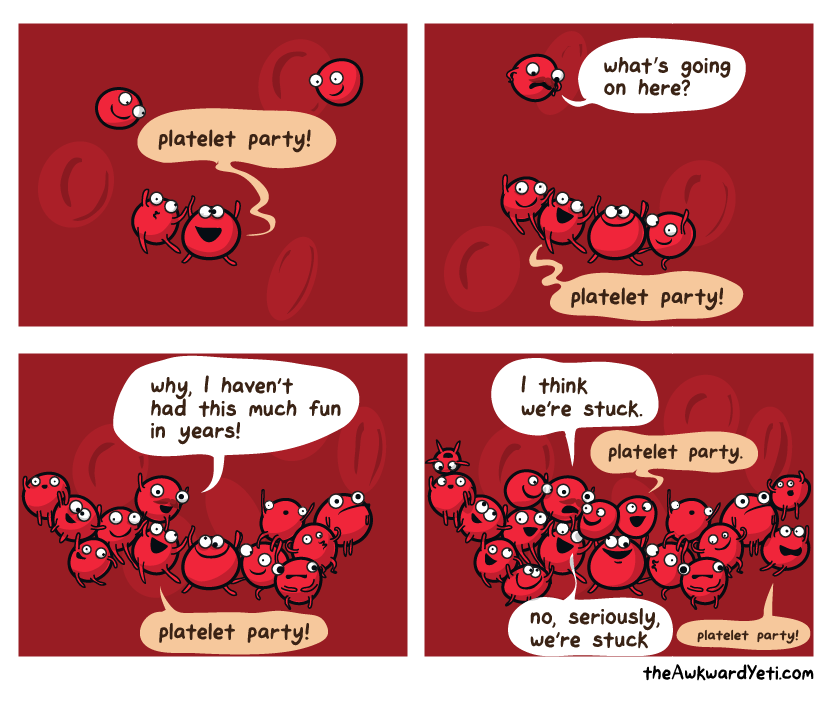 Heparin-induced Thrombocytopenia (HIT)https://abs.twimg.com/emoji/v2/... draggable="false" alt="🩸" title="Tropfen Blut" aria-label="Emoji: Tropfen Blut">!This #tweetorial is a deep dive into Episode 43 of Run the List (RTL) on Thrombocytopenia: https://bit.ly/32feVfQ&q... @LeelaChock for covering this week’s topic!" title="Let& #39;s HIT the topic https://abs.twimg.com/emoji/v2/... draggable="false" alt="💊" title="Tablette" aria-label="Emoji: Tablette"> Heparin-induced Thrombocytopenia (HIT)https://abs.twimg.com/emoji/v2/... draggable="false" alt="🩸" title="Tropfen Blut" aria-label="Emoji: Tropfen Blut">!This #tweetorial is a deep dive into Episode 43 of Run the List (RTL) on Thrombocytopenia: https://bit.ly/32feVfQ&q... @LeelaChock for covering this week’s topic!" class="img-responsive" style="max-width:100%;"/>
Heparin-induced Thrombocytopenia (HIT)https://abs.twimg.com/emoji/v2/... draggable="false" alt="🩸" title="Tropfen Blut" aria-label="Emoji: Tropfen Blut">!This #tweetorial is a deep dive into Episode 43 of Run the List (RTL) on Thrombocytopenia: https://bit.ly/32feVfQ&q... @LeelaChock for covering this week’s topic!" title="Let& #39;s HIT the topic https://abs.twimg.com/emoji/v2/... draggable="false" alt="💊" title="Tablette" aria-label="Emoji: Tablette"> Heparin-induced Thrombocytopenia (HIT)https://abs.twimg.com/emoji/v2/... draggable="false" alt="🩸" title="Tropfen Blut" aria-label="Emoji: Tropfen Blut">!This #tweetorial is a deep dive into Episode 43 of Run the List (RTL) on Thrombocytopenia: https://bit.ly/32feVfQ&q... @LeelaChock for covering this week’s topic!" class="img-responsive" style="max-width:100%;"/>
 Broadly, there are THREE umbrellas:1. https://abs.twimg.com/emoji/v2/... draggable="false" alt="⬆️" title="Pfeil nach oben" aria-label="Emoji: Pfeil nach oben"> destruction2. Splenic sequestration https://abs.twimg.com/emoji/v2/... draggable="false" alt="💪" title="Angespannter Bizeps" aria-label="Emoji: Angespannter Bizeps">3. https://abs.twimg.com/emoji/v2/... draggable="false" alt="⬇️" title="Pfeil nach unten" aria-label="Emoji: Pfeil nach unten"> production https://www.runthelistpodcast.com/s/RTL_Thr..." title="Thrombocytopenia is a broad topic!In Ep. 43 of RTL, Dr. Robert Stern, @NavinKumarMD, & @sonorato11 go over a general approach to thrombocytopenia https://abs.twimg.com/emoji/v2/... draggable="false" alt="👇" title="Rückhand Zeigefinger nach unten" aria-label="Emoji: Rückhand Zeigefinger nach unten">Broadly, there are THREE umbrellas:1. https://abs.twimg.com/emoji/v2/... draggable="false" alt="⬆️" title="Pfeil nach oben" aria-label="Emoji: Pfeil nach oben"> destruction2. Splenic sequestration https://abs.twimg.com/emoji/v2/... draggable="false" alt="💪" title="Angespannter Bizeps" aria-label="Emoji: Angespannter Bizeps">3. https://abs.twimg.com/emoji/v2/... draggable="false" alt="⬇️" title="Pfeil nach unten" aria-label="Emoji: Pfeil nach unten"> production https://www.runthelistpodcast.com/s/RTL_Thr..." class="img-responsive" style="max-width:100%;"/>
Broadly, there are THREE umbrellas:1. https://abs.twimg.com/emoji/v2/... draggable="false" alt="⬆️" title="Pfeil nach oben" aria-label="Emoji: Pfeil nach oben"> destruction2. Splenic sequestration https://abs.twimg.com/emoji/v2/... draggable="false" alt="💪" title="Angespannter Bizeps" aria-label="Emoji: Angespannter Bizeps">3. https://abs.twimg.com/emoji/v2/... draggable="false" alt="⬇️" title="Pfeil nach unten" aria-label="Emoji: Pfeil nach unten"> production https://www.runthelistpodcast.com/s/RTL_Thr..." title="Thrombocytopenia is a broad topic!In Ep. 43 of RTL, Dr. Robert Stern, @NavinKumarMD, & @sonorato11 go over a general approach to thrombocytopenia https://abs.twimg.com/emoji/v2/... draggable="false" alt="👇" title="Rückhand Zeigefinger nach unten" aria-label="Emoji: Rückhand Zeigefinger nach unten">Broadly, there are THREE umbrellas:1. https://abs.twimg.com/emoji/v2/... draggable="false" alt="⬆️" title="Pfeil nach oben" aria-label="Emoji: Pfeil nach oben"> destruction2. Splenic sequestration https://abs.twimg.com/emoji/v2/... draggable="false" alt="💪" title="Angespannter Bizeps" aria-label="Emoji: Angespannter Bizeps">3. https://abs.twimg.com/emoji/v2/... draggable="false" alt="⬇️" title="Pfeil nach unten" aria-label="Emoji: Pfeil nach unten"> production https://www.runthelistpodcast.com/s/RTL_Thr..." class="img-responsive" style="max-width:100%;"/>
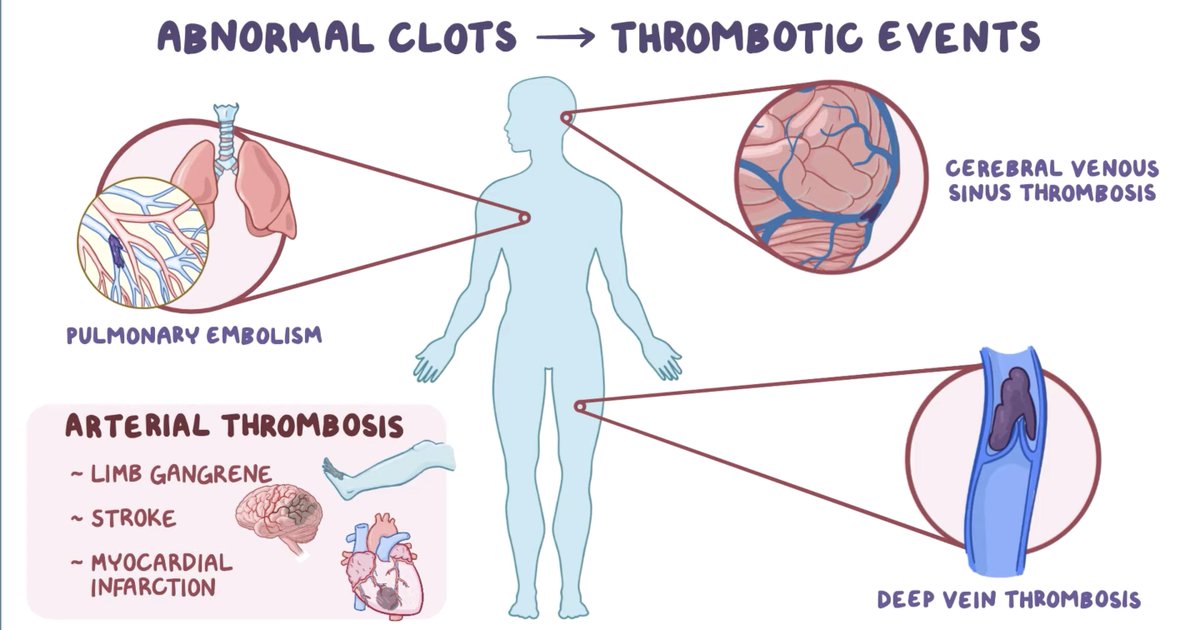 destruction”HIT in-depth:https://abs.twimg.com/emoji/v2/... draggable="false" alt="✨" title="Funken" aria-label="Emoji: Funken">It is *common*, occurring in 1 out of 5,000 hospitalized patientshttps://abs.twimg.com/emoji/v2/... draggable="false" alt="✨" title="Funken" aria-label="Emoji: Funken">https://abs.twimg.com/emoji/v2/... draggable="false" alt="💥" title="Symbol für eine Kollision" aria-label="Emoji: Symbol für eine Kollision">It’s a can’t miss dx! 50% of patients w/ HIT who are not appropriately treated go on to develop a thrombosishttps://abs.twimg.com/emoji/v2/... draggable="false" alt="💥" title="Symbol für eine Kollision" aria-label="Emoji: Symbol für eine Kollision">" title="HIT (Heparin-induced thrombocytopenia), is classified under “https://abs.twimg.com/emoji/v2/... draggable="false" alt="⬆️" title="Pfeil nach oben" aria-label="Emoji: Pfeil nach oben"> destruction”HIT in-depth:https://abs.twimg.com/emoji/v2/... draggable="false" alt="✨" title="Funken" aria-label="Emoji: Funken">It is *common*, occurring in 1 out of 5,000 hospitalized patientshttps://abs.twimg.com/emoji/v2/... draggable="false" alt="✨" title="Funken" aria-label="Emoji: Funken">https://abs.twimg.com/emoji/v2/... draggable="false" alt="💥" title="Symbol für eine Kollision" aria-label="Emoji: Symbol für eine Kollision">It’s a can’t miss dx! 50% of patients w/ HIT who are not appropriately treated go on to develop a thrombosishttps://abs.twimg.com/emoji/v2/... draggable="false" alt="💥" title="Symbol für eine Kollision" aria-label="Emoji: Symbol für eine Kollision">" class="img-responsive" style="max-width:100%;"/>
destruction”HIT in-depth:https://abs.twimg.com/emoji/v2/... draggable="false" alt="✨" title="Funken" aria-label="Emoji: Funken">It is *common*, occurring in 1 out of 5,000 hospitalized patientshttps://abs.twimg.com/emoji/v2/... draggable="false" alt="✨" title="Funken" aria-label="Emoji: Funken">https://abs.twimg.com/emoji/v2/... draggable="false" alt="💥" title="Symbol für eine Kollision" aria-label="Emoji: Symbol für eine Kollision">It’s a can’t miss dx! 50% of patients w/ HIT who are not appropriately treated go on to develop a thrombosishttps://abs.twimg.com/emoji/v2/... draggable="false" alt="💥" title="Symbol für eine Kollision" aria-label="Emoji: Symbol für eine Kollision">" title="HIT (Heparin-induced thrombocytopenia), is classified under “https://abs.twimg.com/emoji/v2/... draggable="false" alt="⬆️" title="Pfeil nach oben" aria-label="Emoji: Pfeil nach oben"> destruction”HIT in-depth:https://abs.twimg.com/emoji/v2/... draggable="false" alt="✨" title="Funken" aria-label="Emoji: Funken">It is *common*, occurring in 1 out of 5,000 hospitalized patientshttps://abs.twimg.com/emoji/v2/... draggable="false" alt="✨" title="Funken" aria-label="Emoji: Funken">https://abs.twimg.com/emoji/v2/... draggable="false" alt="💥" title="Symbol für eine Kollision" aria-label="Emoji: Symbol für eine Kollision">It’s a can’t miss dx! 50% of patients w/ HIT who are not appropriately treated go on to develop a thrombosishttps://abs.twimg.com/emoji/v2/... draggable="false" alt="💥" title="Symbol für eine Kollision" aria-label="Emoji: Symbol für eine Kollision">" class="img-responsive" style="max-width:100%;"/>
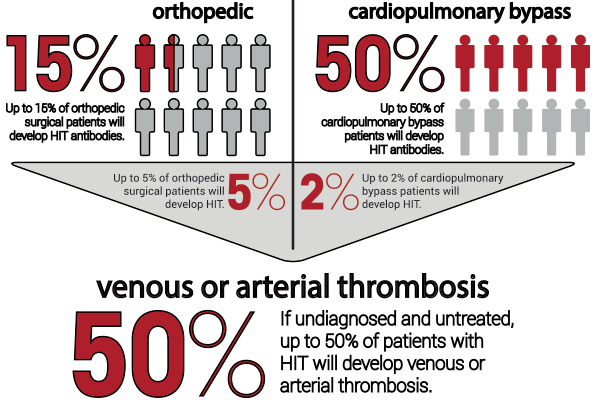 duration/dose of heparin administration (can even happen w/ simple heparin flush!)Type of heparin used: UFH > LMWH > fondaparinuxhttps://abs.twimg.com/emoji/v2/... draggable="false" alt="💊" title="Tablette" aria-label="Emoji: Tablette">https://abs.twimg.com/emoji/v2/... draggable="false" alt="🩹" title="Pflaster" aria-label="Emoji: Pflaster">Surgical, trauma, cardiopulm bypass pts at https://abs.twimg.com/emoji/v2/... draggable="false" alt="⬆️" title="Pfeil nach oben" aria-label="Emoji: Pfeil nach oben"> risk (maybe 2/2 increased heparin use, but MoA unknown)Patient sex (F>M)" title="HIT risk factors?https://abs.twimg.com/emoji/v2/... draggable="false" alt="⬆️" title="Pfeil nach oben" aria-label="Emoji: Pfeil nach oben"> duration/dose of heparin administration (can even happen w/ simple heparin flush!)Type of heparin used: UFH > LMWH > fondaparinuxhttps://abs.twimg.com/emoji/v2/... draggable="false" alt="💊" title="Tablette" aria-label="Emoji: Tablette">https://abs.twimg.com/emoji/v2/... draggable="false" alt="🩹" title="Pflaster" aria-label="Emoji: Pflaster">Surgical, trauma, cardiopulm bypass pts at https://abs.twimg.com/emoji/v2/... draggable="false" alt="⬆️" title="Pfeil nach oben" aria-label="Emoji: Pfeil nach oben"> risk (maybe 2/2 increased heparin use, but MoA unknown)Patient sex (F>M)" class="img-responsive" style="max-width:100%;"/>
duration/dose of heparin administration (can even happen w/ simple heparin flush!)Type of heparin used: UFH > LMWH > fondaparinuxhttps://abs.twimg.com/emoji/v2/... draggable="false" alt="💊" title="Tablette" aria-label="Emoji: Tablette">https://abs.twimg.com/emoji/v2/... draggable="false" alt="🩹" title="Pflaster" aria-label="Emoji: Pflaster">Surgical, trauma, cardiopulm bypass pts at https://abs.twimg.com/emoji/v2/... draggable="false" alt="⬆️" title="Pfeil nach oben" aria-label="Emoji: Pfeil nach oben"> risk (maybe 2/2 increased heparin use, but MoA unknown)Patient sex (F>M)" title="HIT risk factors?https://abs.twimg.com/emoji/v2/... draggable="false" alt="⬆️" title="Pfeil nach oben" aria-label="Emoji: Pfeil nach oben"> duration/dose of heparin administration (can even happen w/ simple heparin flush!)Type of heparin used: UFH > LMWH > fondaparinuxhttps://abs.twimg.com/emoji/v2/... draggable="false" alt="💊" title="Tablette" aria-label="Emoji: Tablette">https://abs.twimg.com/emoji/v2/... draggable="false" alt="🩹" title="Pflaster" aria-label="Emoji: Pflaster">Surgical, trauma, cardiopulm bypass pts at https://abs.twimg.com/emoji/v2/... draggable="false" alt="⬆️" title="Pfeil nach oben" aria-label="Emoji: Pfeil nach oben"> risk (maybe 2/2 increased heparin use, but MoA unknown)Patient sex (F>M)" class="img-responsive" style="max-width:100%;"/>
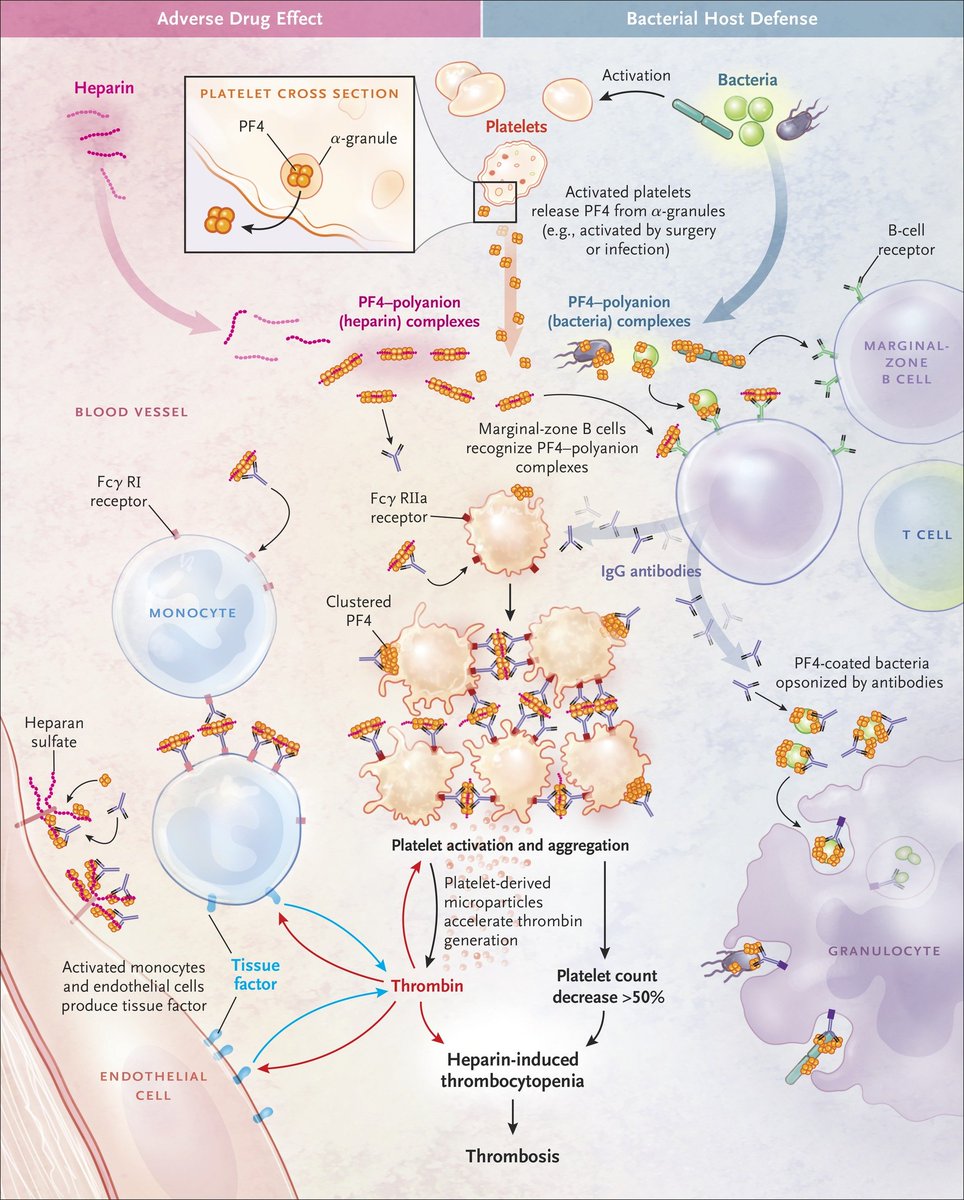 Heparin https://abs.twimg.com/emoji/v2/... draggable="false" alt="💊" title="Tablette" aria-label="Emoji: Tablette"> complexes w/ platelet factor 4 (PF-4), a protein released by plateletshttps://abs.twimg.com/emoji/v2/... draggable="false" alt="▶" title="Nach rechts zeigendes Dreieck" aria-label="Emoji: Nach rechts zeigendes Dreieck"> B-cells make IgG antibodies (~5-7 days after heparin exposure) to the PF4-heparin complex https://abs.twimg.com/emoji/v2/... draggable="false" alt="🧪" title="Test tube" aria-label="Emoji: Test tube">https://abs.twimg.com/emoji/v2/... draggable="false" alt="▶" title="Nach rechts zeigendes Dreieck" aria-label="Emoji: Nach rechts zeigendes Dreieck"> IgG then binds these heparin-PF4 complexes to platelets and then…" title="HIT mechanism: https://abs.twimg.com/emoji/v2/... draggable="false" alt="▶" title="Nach rechts zeigendes Dreieck" aria-label="Emoji: Nach rechts zeigendes Dreieck"> Heparin https://abs.twimg.com/emoji/v2/... draggable="false" alt="💊" title="Tablette" aria-label="Emoji: Tablette"> complexes w/ platelet factor 4 (PF-4), a protein released by plateletshttps://abs.twimg.com/emoji/v2/... draggable="false" alt="▶" title="Nach rechts zeigendes Dreieck" aria-label="Emoji: Nach rechts zeigendes Dreieck"> B-cells make IgG antibodies (~5-7 days after heparin exposure) to the PF4-heparin complex https://abs.twimg.com/emoji/v2/... draggable="false" alt="🧪" title="Test tube" aria-label="Emoji: Test tube">https://abs.twimg.com/emoji/v2/... draggable="false" alt="▶" title="Nach rechts zeigendes Dreieck" aria-label="Emoji: Nach rechts zeigendes Dreieck"> IgG then binds these heparin-PF4 complexes to platelets and then…" class="img-responsive" style="max-width:100%;"/>
Heparin https://abs.twimg.com/emoji/v2/... draggable="false" alt="💊" title="Tablette" aria-label="Emoji: Tablette"> complexes w/ platelet factor 4 (PF-4), a protein released by plateletshttps://abs.twimg.com/emoji/v2/... draggable="false" alt="▶" title="Nach rechts zeigendes Dreieck" aria-label="Emoji: Nach rechts zeigendes Dreieck"> B-cells make IgG antibodies (~5-7 days after heparin exposure) to the PF4-heparin complex https://abs.twimg.com/emoji/v2/... draggable="false" alt="🧪" title="Test tube" aria-label="Emoji: Test tube">https://abs.twimg.com/emoji/v2/... draggable="false" alt="▶" title="Nach rechts zeigendes Dreieck" aria-label="Emoji: Nach rechts zeigendes Dreieck"> IgG then binds these heparin-PF4 complexes to platelets and then…" title="HIT mechanism: https://abs.twimg.com/emoji/v2/... draggable="false" alt="▶" title="Nach rechts zeigendes Dreieck" aria-label="Emoji: Nach rechts zeigendes Dreieck"> Heparin https://abs.twimg.com/emoji/v2/... draggable="false" alt="💊" title="Tablette" aria-label="Emoji: Tablette"> complexes w/ platelet factor 4 (PF-4), a protein released by plateletshttps://abs.twimg.com/emoji/v2/... draggable="false" alt="▶" title="Nach rechts zeigendes Dreieck" aria-label="Emoji: Nach rechts zeigendes Dreieck"> B-cells make IgG antibodies (~5-7 days after heparin exposure) to the PF4-heparin complex https://abs.twimg.com/emoji/v2/... draggable="false" alt="🧪" title="Test tube" aria-label="Emoji: Test tube">https://abs.twimg.com/emoji/v2/... draggable="false" alt="▶" title="Nach rechts zeigendes Dreieck" aria-label="Emoji: Nach rechts zeigendes Dreieck"> IgG then binds these heparin-PF4 complexes to platelets and then…" class="img-responsive" style="max-width:100%;"/>
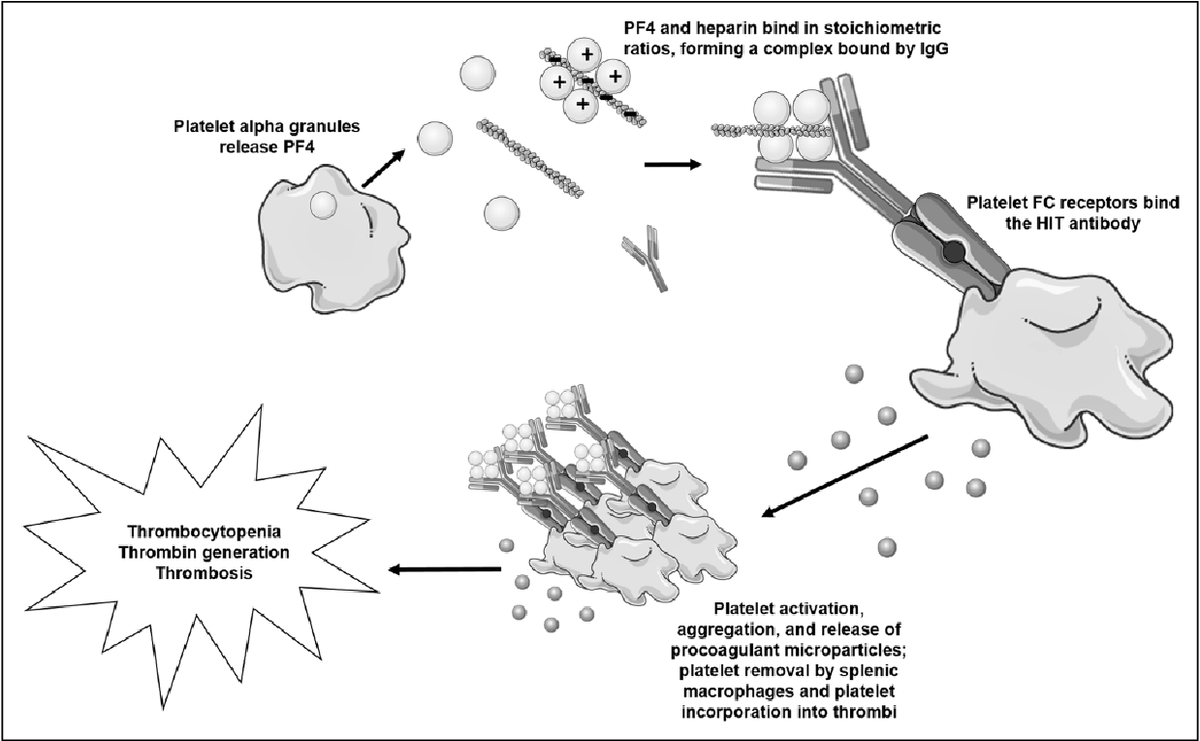 Thrombocytopenia by marking the platelets for https://abs.twimg.com/emoji/v2/... draggable="false" alt="☠️" title="Totenkopf" aria-label="Emoji: Totenkopf">destructionhttps://abs.twimg.com/emoji/v2/... draggable="false" alt="☠️" title="Totenkopf" aria-label="Emoji: Totenkopf"> via splenic macrophages (type II hypersensitivity rxn)ANDhttps://abs.twimg.com/emoji/v2/... draggable="false" alt="2⃣" title="Tastenkappe Ziffer 2" aria-label="Emoji: Tastenkappe Ziffer 2">Paradoxical PRO-thrombotic state by IgG Ab complexes https://abs.twimg.com/emoji/v2/... draggable="false" alt="💥" title="Symbol für eine Kollision" aria-label="Emoji: Symbol für eine Kollision">activatinghttps://abs.twimg.com/emoji/v2/... draggable="false" alt="💥" title="Symbol für eine Kollision" aria-label="Emoji: Symbol für eine Kollision"> platelets!" title="(HIT MoA cont.):IgG-PF4-heparin complexes bind platelets causing BOTH:https://abs.twimg.com/emoji/v2/... draggable="false" alt="1⃣" title="Tastenkappe Ziffer 1" aria-label="Emoji: Tastenkappe Ziffer 1">Thrombocytopenia by marking the platelets for https://abs.twimg.com/emoji/v2/... draggable="false" alt="☠️" title="Totenkopf" aria-label="Emoji: Totenkopf">destructionhttps://abs.twimg.com/emoji/v2/... draggable="false" alt="☠️" title="Totenkopf" aria-label="Emoji: Totenkopf"> via splenic macrophages (type II hypersensitivity rxn)ANDhttps://abs.twimg.com/emoji/v2/... draggable="false" alt="2⃣" title="Tastenkappe Ziffer 2" aria-label="Emoji: Tastenkappe Ziffer 2">Paradoxical PRO-thrombotic state by IgG Ab complexes https://abs.twimg.com/emoji/v2/... draggable="false" alt="💥" title="Symbol für eine Kollision" aria-label="Emoji: Symbol für eine Kollision">activatinghttps://abs.twimg.com/emoji/v2/... draggable="false" alt="💥" title="Symbol für eine Kollision" aria-label="Emoji: Symbol für eine Kollision"> platelets!" class="img-responsive" style="max-width:100%;"/>
Thrombocytopenia by marking the platelets for https://abs.twimg.com/emoji/v2/... draggable="false" alt="☠️" title="Totenkopf" aria-label="Emoji: Totenkopf">destructionhttps://abs.twimg.com/emoji/v2/... draggable="false" alt="☠️" title="Totenkopf" aria-label="Emoji: Totenkopf"> via splenic macrophages (type II hypersensitivity rxn)ANDhttps://abs.twimg.com/emoji/v2/... draggable="false" alt="2⃣" title="Tastenkappe Ziffer 2" aria-label="Emoji: Tastenkappe Ziffer 2">Paradoxical PRO-thrombotic state by IgG Ab complexes https://abs.twimg.com/emoji/v2/... draggable="false" alt="💥" title="Symbol für eine Kollision" aria-label="Emoji: Symbol für eine Kollision">activatinghttps://abs.twimg.com/emoji/v2/... draggable="false" alt="💥" title="Symbol für eine Kollision" aria-label="Emoji: Symbol für eine Kollision"> platelets!" title="(HIT MoA cont.):IgG-PF4-heparin complexes bind platelets causing BOTH:https://abs.twimg.com/emoji/v2/... draggable="false" alt="1⃣" title="Tastenkappe Ziffer 1" aria-label="Emoji: Tastenkappe Ziffer 1">Thrombocytopenia by marking the platelets for https://abs.twimg.com/emoji/v2/... draggable="false" alt="☠️" title="Totenkopf" aria-label="Emoji: Totenkopf">destructionhttps://abs.twimg.com/emoji/v2/... draggable="false" alt="☠️" title="Totenkopf" aria-label="Emoji: Totenkopf"> via splenic macrophages (type II hypersensitivity rxn)ANDhttps://abs.twimg.com/emoji/v2/... draggable="false" alt="2⃣" title="Tastenkappe Ziffer 2" aria-label="Emoji: Tastenkappe Ziffer 2">Paradoxical PRO-thrombotic state by IgG Ab complexes https://abs.twimg.com/emoji/v2/... draggable="false" alt="💥" title="Symbol für eine Kollision" aria-label="Emoji: Symbol für eine Kollision">activatinghttps://abs.twimg.com/emoji/v2/... draggable="false" alt="💥" title="Symbol für eine Kollision" aria-label="Emoji: Symbol für eine Kollision"> platelets!" class="img-responsive" style="max-width:100%;"/>
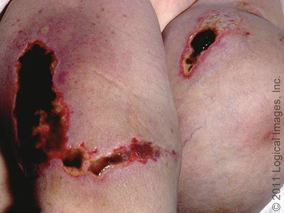 Thrombocytopenia to ~50-80k (usually >20K)https://abs.twimg.com/emoji/v2/... draggable="false" alt="🟠" title="Orangefarbener Kreis" aria-label="Emoji: Orangefarbener Kreis">Paradoxical thrombosis (venous > arterial), despite thrombocytopenia!https://abs.twimg.com/emoji/v2/... draggable="false" alt="🟡" title="Gelber Kreis" aria-label="Emoji: Gelber Kreis">(Rarely) anaphylaxis; HIT Ab may activate leukocyteshttps://abs.twimg.com/emoji/v2/... draggable="false" alt="🟢" title="Grüner Kreis" aria-label="Emoji: Grüner Kreis">Skin necrosis at *heparin injection sites* (seen below) immediately suggests HIT! https://abs.twimg.com/emoji/v2/... draggable="false" alt="🩺" title="Stethoskop" aria-label="Emoji: Stethoskop">" title="Sequelae include:https://abs.twimg.com/emoji/v2/... draggable="false" alt="🔴" title="Roter Kreis" aria-label="Emoji: Roter Kreis">Thrombocytopenia to ~50-80k (usually >20K)https://abs.twimg.com/emoji/v2/... draggable="false" alt="🟠" title="Orangefarbener Kreis" aria-label="Emoji: Orangefarbener Kreis">Paradoxical thrombosis (venous > arterial), despite thrombocytopenia!https://abs.twimg.com/emoji/v2/... draggable="false" alt="🟡" title="Gelber Kreis" aria-label="Emoji: Gelber Kreis">(Rarely) anaphylaxis; HIT Ab may activate leukocyteshttps://abs.twimg.com/emoji/v2/... draggable="false" alt="🟢" title="Grüner Kreis" aria-label="Emoji: Grüner Kreis">Skin necrosis at *heparin injection sites* (seen below) immediately suggests HIT! https://abs.twimg.com/emoji/v2/... draggable="false" alt="🩺" title="Stethoskop" aria-label="Emoji: Stethoskop">" class="img-responsive" style="max-width:100%;"/>
Thrombocytopenia to ~50-80k (usually >20K)https://abs.twimg.com/emoji/v2/... draggable="false" alt="🟠" title="Orangefarbener Kreis" aria-label="Emoji: Orangefarbener Kreis">Paradoxical thrombosis (venous > arterial), despite thrombocytopenia!https://abs.twimg.com/emoji/v2/... draggable="false" alt="🟡" title="Gelber Kreis" aria-label="Emoji: Gelber Kreis">(Rarely) anaphylaxis; HIT Ab may activate leukocyteshttps://abs.twimg.com/emoji/v2/... draggable="false" alt="🟢" title="Grüner Kreis" aria-label="Emoji: Grüner Kreis">Skin necrosis at *heparin injection sites* (seen below) immediately suggests HIT! https://abs.twimg.com/emoji/v2/... draggable="false" alt="🩺" title="Stethoskop" aria-label="Emoji: Stethoskop">" title="Sequelae include:https://abs.twimg.com/emoji/v2/... draggable="false" alt="🔴" title="Roter Kreis" aria-label="Emoji: Roter Kreis">Thrombocytopenia to ~50-80k (usually >20K)https://abs.twimg.com/emoji/v2/... draggable="false" alt="🟠" title="Orangefarbener Kreis" aria-label="Emoji: Orangefarbener Kreis">Paradoxical thrombosis (venous > arterial), despite thrombocytopenia!https://abs.twimg.com/emoji/v2/... draggable="false" alt="🟡" title="Gelber Kreis" aria-label="Emoji: Gelber Kreis">(Rarely) anaphylaxis; HIT Ab may activate leukocyteshttps://abs.twimg.com/emoji/v2/... draggable="false" alt="🟢" title="Grüner Kreis" aria-label="Emoji: Grüner Kreis">Skin necrosis at *heparin injection sites* (seen below) immediately suggests HIT! https://abs.twimg.com/emoji/v2/... draggable="false" alt="🩺" title="Stethoskop" aria-label="Emoji: Stethoskop">" class="img-responsive" style="max-width:100%;"/>
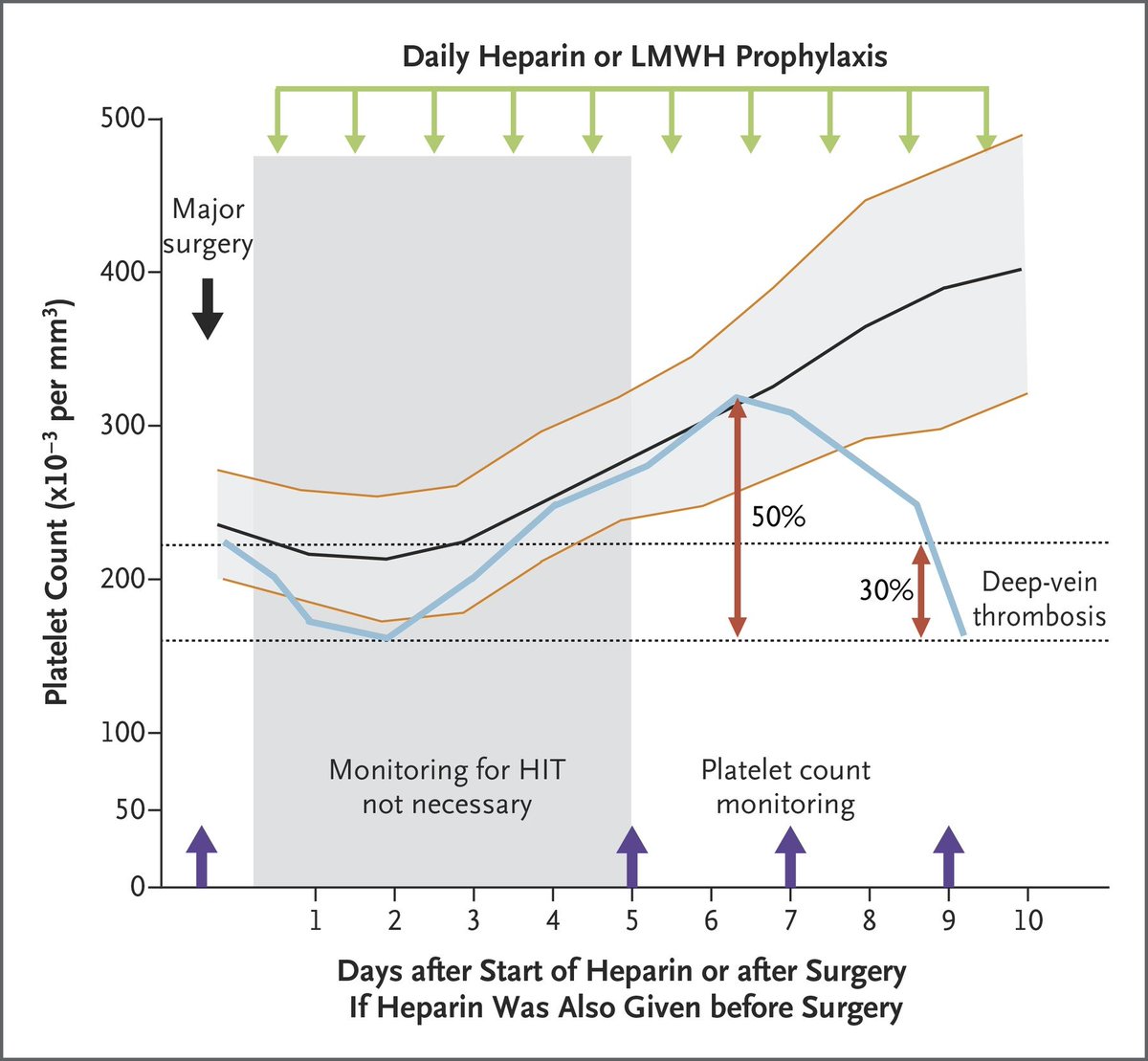 of HIT!Suppose heparin is given on day 0:https://abs.twimg.com/emoji/v2/... draggable="false" alt="🔸" title="Kleine orangene Raute" aria-label="Emoji: Kleine orangene Raute">d0-d1 = Rapid 50% drop (pt already has IgG Ab 2/2 heparin exposure w/i last 3 months)https://abs.twimg.com/emoji/v2/... draggable="false" alt="🔹" title="Kleine blaue Raute" aria-label="Emoji: Kleine blaue Raute">d5-d7 = Rapid 50% drop (no prior heparin exposure)https://abs.twimg.com/emoji/v2/... draggable="false" alt="🔸" title="Kleine orangene Raute" aria-label="Emoji: Kleine orangene Raute">d7-d14 after heparin withdrawal = Rapid drop ("delayed-onset HIT")" title="Let’s review timing https://abs.twimg.com/emoji/v2/... draggable="false" alt="⏰" title="Wecker" aria-label="Emoji: Wecker"> of HIT!Suppose heparin is given on day 0:https://abs.twimg.com/emoji/v2/... draggable="false" alt="🔸" title="Kleine orangene Raute" aria-label="Emoji: Kleine orangene Raute">d0-d1 = Rapid 50% drop (pt already has IgG Ab 2/2 heparin exposure w/i last 3 months)https://abs.twimg.com/emoji/v2/... draggable="false" alt="🔹" title="Kleine blaue Raute" aria-label="Emoji: Kleine blaue Raute">d5-d7 = Rapid 50% drop (no prior heparin exposure)https://abs.twimg.com/emoji/v2/... draggable="false" alt="🔸" title="Kleine orangene Raute" aria-label="Emoji: Kleine orangene Raute">d7-d14 after heparin withdrawal = Rapid drop ("delayed-onset HIT")" class="img-responsive" style="max-width:100%;"/>
of HIT!Suppose heparin is given on day 0:https://abs.twimg.com/emoji/v2/... draggable="false" alt="🔸" title="Kleine orangene Raute" aria-label="Emoji: Kleine orangene Raute">d0-d1 = Rapid 50% drop (pt already has IgG Ab 2/2 heparin exposure w/i last 3 months)https://abs.twimg.com/emoji/v2/... draggable="false" alt="🔹" title="Kleine blaue Raute" aria-label="Emoji: Kleine blaue Raute">d5-d7 = Rapid 50% drop (no prior heparin exposure)https://abs.twimg.com/emoji/v2/... draggable="false" alt="🔸" title="Kleine orangene Raute" aria-label="Emoji: Kleine orangene Raute">d7-d14 after heparin withdrawal = Rapid drop ("delayed-onset HIT")" title="Let’s review timing https://abs.twimg.com/emoji/v2/... draggable="false" alt="⏰" title="Wecker" aria-label="Emoji: Wecker"> of HIT!Suppose heparin is given on day 0:https://abs.twimg.com/emoji/v2/... draggable="false" alt="🔸" title="Kleine orangene Raute" aria-label="Emoji: Kleine orangene Raute">d0-d1 = Rapid 50% drop (pt already has IgG Ab 2/2 heparin exposure w/i last 3 months)https://abs.twimg.com/emoji/v2/... draggable="false" alt="🔹" title="Kleine blaue Raute" aria-label="Emoji: Kleine blaue Raute">d5-d7 = Rapid 50% drop (no prior heparin exposure)https://abs.twimg.com/emoji/v2/... draggable="false" alt="🔸" title="Kleine orangene Raute" aria-label="Emoji: Kleine orangene Raute">d7-d14 after heparin withdrawal = Rapid drop ("delayed-onset HIT")" class="img-responsive" style="max-width:100%;"/>
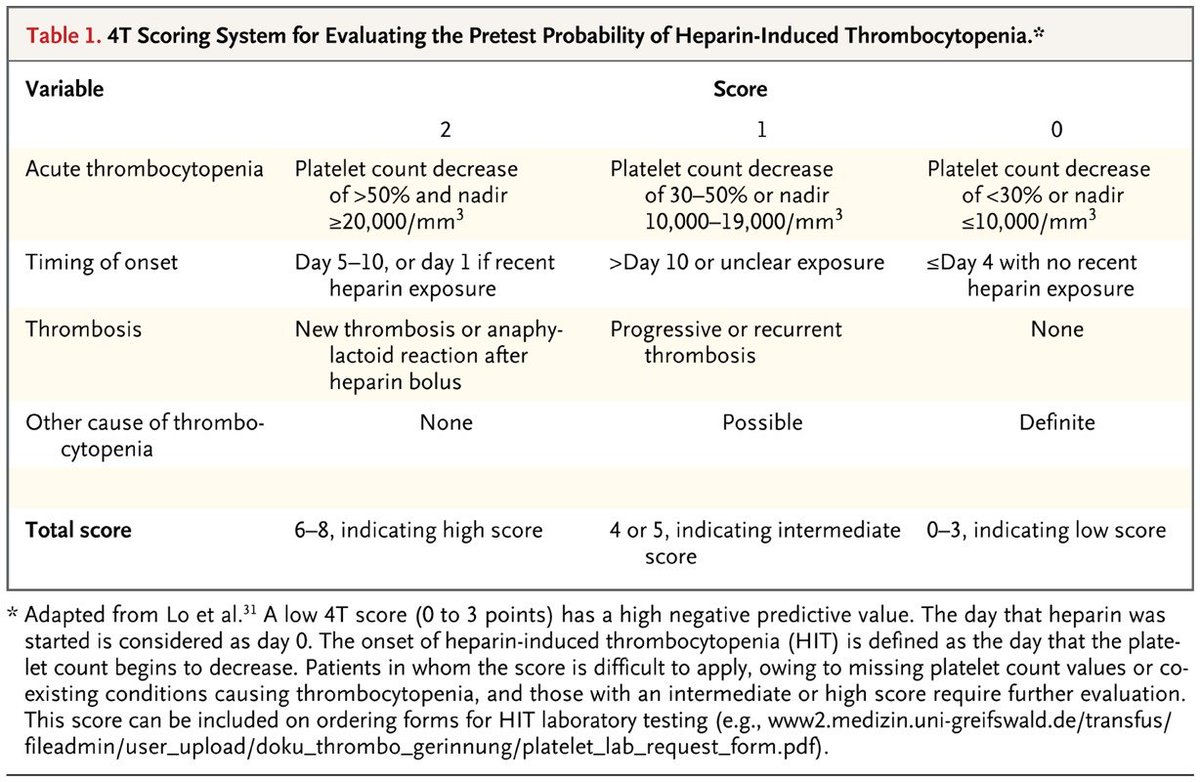 Thrombocytopeniahttps://abs.twimg.com/emoji/v2/... draggable="false" alt="📌" title="Reißzwecke" aria-label="Emoji: Reißzwecke">Timing https://abs.twimg.com/emoji/v2/... draggable="false" alt="⌚️" title="Armbanduhr" aria-label="Emoji: Armbanduhr"> of Onsethttps://abs.twimg.com/emoji/v2/... draggable="false" alt="📌" title="Reißzwecke" aria-label="Emoji: Reißzwecke">Thrombosishttps://abs.twimg.com/emoji/v2/... draggable="false" alt="📌" title="Reißzwecke" aria-label="Emoji: Reißzwecke">oTher causes of Thrombocytopenia.A LOW score (<4 points) has a very HIGH negative predictive value (NPV) of 97 to 99%, and essentially *rules out* HIT" title="If suspecting HIT calculate a "4-T score"The 4 T& #39;s are:https://abs.twimg.com/emoji/v2/... draggable="false" alt="📌" title="Reißzwecke" aria-label="Emoji: Reißzwecke">Thrombocytopeniahttps://abs.twimg.com/emoji/v2/... draggable="false" alt="📌" title="Reißzwecke" aria-label="Emoji: Reißzwecke">Timing https://abs.twimg.com/emoji/v2/... draggable="false" alt="⌚️" title="Armbanduhr" aria-label="Emoji: Armbanduhr"> of Onsethttps://abs.twimg.com/emoji/v2/... draggable="false" alt="📌" title="Reißzwecke" aria-label="Emoji: Reißzwecke">Thrombosishttps://abs.twimg.com/emoji/v2/... draggable="false" alt="📌" title="Reißzwecke" aria-label="Emoji: Reißzwecke">oTher causes of Thrombocytopenia.A LOW score (<4 points) has a very HIGH negative predictive value (NPV) of 97 to 99%, and essentially *rules out* HIT" class="img-responsive" style="max-width:100%;"/>
Thrombocytopeniahttps://abs.twimg.com/emoji/v2/... draggable="false" alt="📌" title="Reißzwecke" aria-label="Emoji: Reißzwecke">Timing https://abs.twimg.com/emoji/v2/... draggable="false" alt="⌚️" title="Armbanduhr" aria-label="Emoji: Armbanduhr"> of Onsethttps://abs.twimg.com/emoji/v2/... draggable="false" alt="📌" title="Reißzwecke" aria-label="Emoji: Reißzwecke">Thrombosishttps://abs.twimg.com/emoji/v2/... draggable="false" alt="📌" title="Reißzwecke" aria-label="Emoji: Reißzwecke">oTher causes of Thrombocytopenia.A LOW score (<4 points) has a very HIGH negative predictive value (NPV) of 97 to 99%, and essentially *rules out* HIT" title="If suspecting HIT calculate a "4-T score"The 4 T& #39;s are:https://abs.twimg.com/emoji/v2/... draggable="false" alt="📌" title="Reißzwecke" aria-label="Emoji: Reißzwecke">Thrombocytopeniahttps://abs.twimg.com/emoji/v2/... draggable="false" alt="📌" title="Reißzwecke" aria-label="Emoji: Reißzwecke">Timing https://abs.twimg.com/emoji/v2/... draggable="false" alt="⌚️" title="Armbanduhr" aria-label="Emoji: Armbanduhr"> of Onsethttps://abs.twimg.com/emoji/v2/... draggable="false" alt="📌" title="Reißzwecke" aria-label="Emoji: Reißzwecke">Thrombosishttps://abs.twimg.com/emoji/v2/... draggable="false" alt="📌" title="Reißzwecke" aria-label="Emoji: Reißzwecke">oTher causes of Thrombocytopenia.A LOW score (<4 points) has a very HIGH negative predictive value (NPV) of 97 to 99%, and essentially *rules out* HIT" class="img-responsive" style="max-width:100%;"/>
 Stopping all heparin products immediately https://abs.twimg.com/emoji/v2/... draggable="false" alt="🛑" title="Stop sign" aria-label="Emoji: Stop sign">!https://abs.twimg.com/emoji/v2/... draggable="false" alt="2⃣" title="Tastenkappe Ziffer 2" aria-label="Emoji: Tastenkappe Ziffer 2">An Anti–PF4–heparin ELISA test https://abs.twimg.com/emoji/v2/... draggable="false" alt="🧪" title="Test tube" aria-label="Emoji: Test tube">https://abs.twimg.com/emoji/v2/... draggable="false" alt="3⃣" title="Tastenkappe Ziffer 3" aria-label="Emoji: Tastenkappe Ziffer 3">Starting therapeutic NON-heparin anticoagulation (e.g. Argatroban https://abs.twimg.com/emoji/v2/... draggable="false" alt="💊" title="Tablette" aria-label="Emoji: Tablette">)" title="The positive predictive value (PPV) of a 4-T score of 4-5 is 10-20%, but a score >=6 is 40-80%A 4-T score >=4 requires:https://abs.twimg.com/emoji/v2/... draggable="false" alt="1⃣" title="Tastenkappe Ziffer 1" aria-label="Emoji: Tastenkappe Ziffer 1">Stopping all heparin products immediately https://abs.twimg.com/emoji/v2/... draggable="false" alt="🛑" title="Stop sign" aria-label="Emoji: Stop sign">!https://abs.twimg.com/emoji/v2/... draggable="false" alt="2⃣" title="Tastenkappe Ziffer 2" aria-label="Emoji: Tastenkappe Ziffer 2">An Anti–PF4–heparin ELISA test https://abs.twimg.com/emoji/v2/... draggable="false" alt="🧪" title="Test tube" aria-label="Emoji: Test tube">https://abs.twimg.com/emoji/v2/... draggable="false" alt="3⃣" title="Tastenkappe Ziffer 3" aria-label="Emoji: Tastenkappe Ziffer 3">Starting therapeutic NON-heparin anticoagulation (e.g. Argatroban https://abs.twimg.com/emoji/v2/... draggable="false" alt="💊" title="Tablette" aria-label="Emoji: Tablette">)" class="img-responsive" style="max-width:100%;"/>
Stopping all heparin products immediately https://abs.twimg.com/emoji/v2/... draggable="false" alt="🛑" title="Stop sign" aria-label="Emoji: Stop sign">!https://abs.twimg.com/emoji/v2/... draggable="false" alt="2⃣" title="Tastenkappe Ziffer 2" aria-label="Emoji: Tastenkappe Ziffer 2">An Anti–PF4–heparin ELISA test https://abs.twimg.com/emoji/v2/... draggable="false" alt="🧪" title="Test tube" aria-label="Emoji: Test tube">https://abs.twimg.com/emoji/v2/... draggable="false" alt="3⃣" title="Tastenkappe Ziffer 3" aria-label="Emoji: Tastenkappe Ziffer 3">Starting therapeutic NON-heparin anticoagulation (e.g. Argatroban https://abs.twimg.com/emoji/v2/... draggable="false" alt="💊" title="Tablette" aria-label="Emoji: Tablette">)" title="The positive predictive value (PPV) of a 4-T score of 4-5 is 10-20%, but a score >=6 is 40-80%A 4-T score >=4 requires:https://abs.twimg.com/emoji/v2/... draggable="false" alt="1⃣" title="Tastenkappe Ziffer 1" aria-label="Emoji: Tastenkappe Ziffer 1">Stopping all heparin products immediately https://abs.twimg.com/emoji/v2/... draggable="false" alt="🛑" title="Stop sign" aria-label="Emoji: Stop sign">!https://abs.twimg.com/emoji/v2/... draggable="false" alt="2⃣" title="Tastenkappe Ziffer 2" aria-label="Emoji: Tastenkappe Ziffer 2">An Anti–PF4–heparin ELISA test https://abs.twimg.com/emoji/v2/... draggable="false" alt="🧪" title="Test tube" aria-label="Emoji: Test tube">https://abs.twimg.com/emoji/v2/... draggable="false" alt="3⃣" title="Tastenkappe Ziffer 3" aria-label="Emoji: Tastenkappe Ziffer 3">Starting therapeutic NON-heparin anticoagulation (e.g. Argatroban https://abs.twimg.com/emoji/v2/... draggable="false" alt="💊" title="Tablette" aria-label="Emoji: Tablette">)" class="img-responsive" style="max-width:100%;"/>
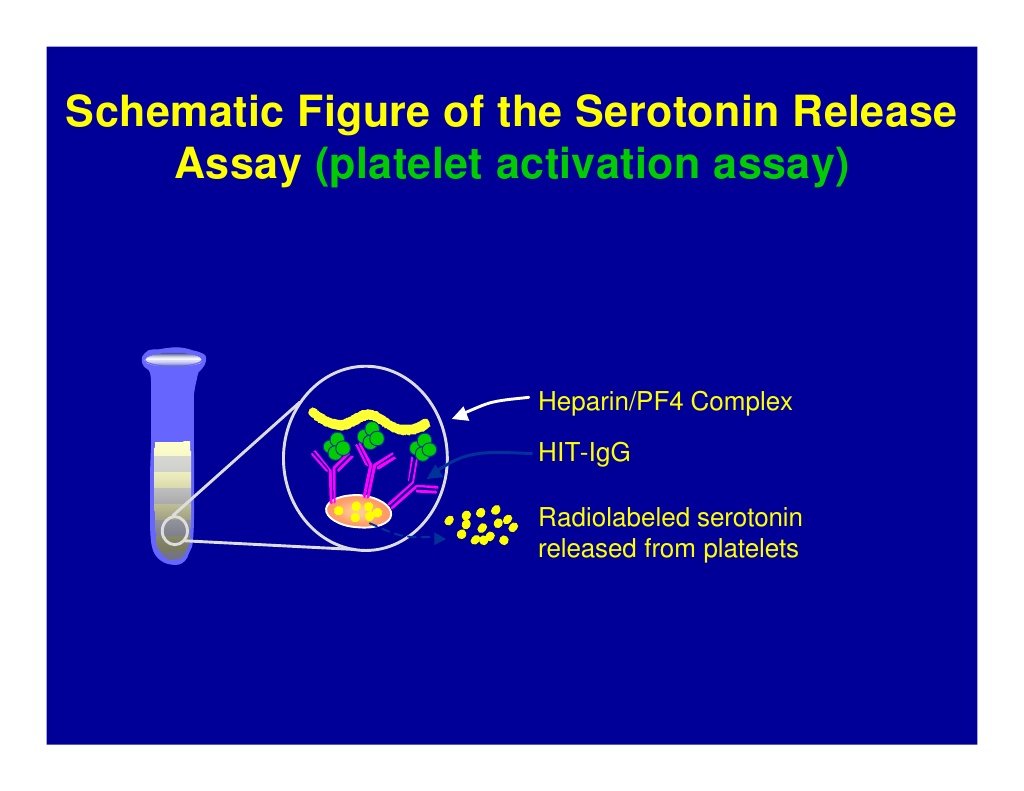 anti-PF4 result requires confirmation w/ *gold standard functional test*: serotonin release assay (SRA)How does SRA work?If pt& #39;s serum has active heparin-PF4 IgG Ab https://abs.twimg.com/emoji/v2/... draggable="false" alt="➡️" title="Pfeil nach rechts" aria-label="Emoji: Pfeil nach rechts"> activate donor platelets https://abs.twimg.com/emoji/v2/... draggable="false" alt="➡️" title="Pfeil nach rechts" aria-label="Emoji: Pfeil nach rechts"> https://abs.twimg.com/emoji/v2/... draggable="false" alt="💥" title="Symbol für eine Kollision" aria-label="Emoji: Symbol für eine Kollision"> releasing serotonin https://abs.twimg.com/emoji/v2/... draggable="false" alt="💥" title="Symbol für eine Kollision" aria-label="Emoji: Symbol für eine Kollision">" title="Anti-PF4 test has high NPV (98-99%), but low PPVa https://abs.twimg.com/emoji/v2/... draggable="false" alt="➕" title="Fettes Pluszeichen" aria-label="Emoji: Fettes Pluszeichen"> anti-PF4 result requires confirmation w/ *gold standard functional test*: serotonin release assay (SRA)How does SRA work?If pt& #39;s serum has active heparin-PF4 IgG Ab https://abs.twimg.com/emoji/v2/... draggable="false" alt="➡️" title="Pfeil nach rechts" aria-label="Emoji: Pfeil nach rechts"> activate donor platelets https://abs.twimg.com/emoji/v2/... draggable="false" alt="➡️" title="Pfeil nach rechts" aria-label="Emoji: Pfeil nach rechts"> https://abs.twimg.com/emoji/v2/... draggable="false" alt="💥" title="Symbol für eine Kollision" aria-label="Emoji: Symbol für eine Kollision"> releasing serotonin https://abs.twimg.com/emoji/v2/... draggable="false" alt="💥" title="Symbol für eine Kollision" aria-label="Emoji: Symbol für eine Kollision">" class="img-responsive" style="max-width:100%;"/>
anti-PF4 result requires confirmation w/ *gold standard functional test*: serotonin release assay (SRA)How does SRA work?If pt& #39;s serum has active heparin-PF4 IgG Ab https://abs.twimg.com/emoji/v2/... draggable="false" alt="➡️" title="Pfeil nach rechts" aria-label="Emoji: Pfeil nach rechts"> activate donor platelets https://abs.twimg.com/emoji/v2/... draggable="false" alt="➡️" title="Pfeil nach rechts" aria-label="Emoji: Pfeil nach rechts"> https://abs.twimg.com/emoji/v2/... draggable="false" alt="💥" title="Symbol für eine Kollision" aria-label="Emoji: Symbol für eine Kollision"> releasing serotonin https://abs.twimg.com/emoji/v2/... draggable="false" alt="💥" title="Symbol für eine Kollision" aria-label="Emoji: Symbol für eine Kollision">" title="Anti-PF4 test has high NPV (98-99%), but low PPVa https://abs.twimg.com/emoji/v2/... draggable="false" alt="➕" title="Fettes Pluszeichen" aria-label="Emoji: Fettes Pluszeichen"> anti-PF4 result requires confirmation w/ *gold standard functional test*: serotonin release assay (SRA)How does SRA work?If pt& #39;s serum has active heparin-PF4 IgG Ab https://abs.twimg.com/emoji/v2/... draggable="false" alt="➡️" title="Pfeil nach rechts" aria-label="Emoji: Pfeil nach rechts"> activate donor platelets https://abs.twimg.com/emoji/v2/... draggable="false" alt="➡️" title="Pfeil nach rechts" aria-label="Emoji: Pfeil nach rechts"> https://abs.twimg.com/emoji/v2/... draggable="false" alt="💥" title="Symbol für eine Kollision" aria-label="Emoji: Symbol für eine Kollision"> releasing serotonin https://abs.twimg.com/emoji/v2/... draggable="false" alt="💥" title="Symbol für eine Kollision" aria-label="Emoji: Symbol für eine Kollision">" class="img-responsive" style="max-width:100%;"/>
 ?HIT Abs activate plateletshttps://abs.twimg.com/emoji/v2/... draggable="false" alt="➡️" title="Pfeil nach rechts" aria-label="Emoji: Pfeil nach rechts">clots despite thrombocytopeniaFor HIT: continue AC until platelet count >150KFor HIT-related clot: continue AC for 3 months (like any provoked clot)" title="All pts w/ suspected or confirmed HIT need therapeutic (non-heparin) anticoagulation (AC)!Whyhttps://abs.twimg.com/emoji/v2/... draggable="false" alt="💊" title="Tablette" aria-label="Emoji: Tablette">?HIT Abs activate plateletshttps://abs.twimg.com/emoji/v2/... draggable="false" alt="➡️" title="Pfeil nach rechts" aria-label="Emoji: Pfeil nach rechts">clots despite thrombocytopeniaFor HIT: continue AC until platelet count >150KFor HIT-related clot: continue AC for 3 months (like any provoked clot)" class="img-responsive" style="max-width:100%;"/>
?HIT Abs activate plateletshttps://abs.twimg.com/emoji/v2/... draggable="false" alt="➡️" title="Pfeil nach rechts" aria-label="Emoji: Pfeil nach rechts">clots despite thrombocytopeniaFor HIT: continue AC until platelet count >150KFor HIT-related clot: continue AC for 3 months (like any provoked clot)" title="All pts w/ suspected or confirmed HIT need therapeutic (non-heparin) anticoagulation (AC)!Whyhttps://abs.twimg.com/emoji/v2/... draggable="false" alt="💊" title="Tablette" aria-label="Emoji: Tablette">?HIT Abs activate plateletshttps://abs.twimg.com/emoji/v2/... draggable="false" alt="➡️" title="Pfeil nach rechts" aria-label="Emoji: Pfeil nach rechts">clots despite thrombocytopeniaFor HIT: continue AC until platelet count >150KFor HIT-related clot: continue AC for 3 months (like any provoked clot)" class="img-responsive" style="max-width:100%;"/>
![Tropfen Blut [on AC] @ASH_hematology suggests the following tx as initial anticoagulants in acute HIThttps://abs.twimg.com/emoji/v2/... draggable=](https://pbs.twimg.com/media/EnmWmLIXIAAuEhl.png) :https://abs.twimg.com/emoji/v2/... draggable="false" alt="📝" title="Memo" aria-label="Emoji: Memo">Argatroban, bivalirudin, fondiparinux, danaparoid, or a DOAChttps://abs.twimg.com/emoji/v2/... draggable="false" alt="💊" title="Tablette" aria-label="Emoji: Tablette">Argatroban or bivalirudin = short half-lives (!)https://abs.twimg.com/emoji/v2/... draggable="false" alt="⌛️" title="Sanduhr" aria-label="Emoji: Sanduhr">Short half-lives = indicated for critically ill or bleeding risk pts" title="[on AC] @ASH_hematology suggests the following tx as initial anticoagulants in acute HIThttps://abs.twimg.com/emoji/v2/... draggable="false" alt="🩸" title="Tropfen Blut" aria-label="Emoji: Tropfen Blut">:https://abs.twimg.com/emoji/v2/... draggable="false" alt="📝" title="Memo" aria-label="Emoji: Memo">Argatroban, bivalirudin, fondiparinux, danaparoid, or a DOAChttps://abs.twimg.com/emoji/v2/... draggable="false" alt="💊" title="Tablette" aria-label="Emoji: Tablette">Argatroban or bivalirudin = short half-lives (!)https://abs.twimg.com/emoji/v2/... draggable="false" alt="⌛️" title="Sanduhr" aria-label="Emoji: Sanduhr">Short half-lives = indicated for critically ill or bleeding risk pts" class="img-responsive" style="max-width:100%;"/>
:https://abs.twimg.com/emoji/v2/... draggable="false" alt="📝" title="Memo" aria-label="Emoji: Memo">Argatroban, bivalirudin, fondiparinux, danaparoid, or a DOAChttps://abs.twimg.com/emoji/v2/... draggable="false" alt="💊" title="Tablette" aria-label="Emoji: Tablette">Argatroban or bivalirudin = short half-lives (!)https://abs.twimg.com/emoji/v2/... draggable="false" alt="⌛️" title="Sanduhr" aria-label="Emoji: Sanduhr">Short half-lives = indicated for critically ill or bleeding risk pts" title="[on AC] @ASH_hematology suggests the following tx as initial anticoagulants in acute HIThttps://abs.twimg.com/emoji/v2/... draggable="false" alt="🩸" title="Tropfen Blut" aria-label="Emoji: Tropfen Blut">:https://abs.twimg.com/emoji/v2/... draggable="false" alt="📝" title="Memo" aria-label="Emoji: Memo">Argatroban, bivalirudin, fondiparinux, danaparoid, or a DOAChttps://abs.twimg.com/emoji/v2/... draggable="false" alt="💊" title="Tablette" aria-label="Emoji: Tablette">Argatroban or bivalirudin = short half-lives (!)https://abs.twimg.com/emoji/v2/... draggable="false" alt="⌛️" title="Sanduhr" aria-label="Emoji: Sanduhr">Short half-lives = indicated for critically ill or bleeding risk pts" class="img-responsive" style="max-width:100%;"/>
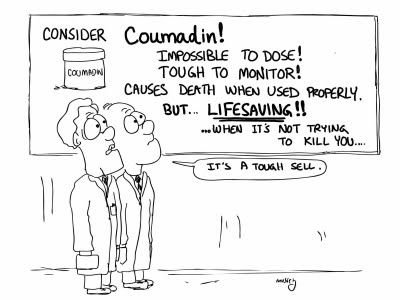 hold warfarinhttps://abs.twimg.com/emoji/v2/... draggable="false" alt="🛑" title="Stop sign" aria-label="Emoji: Stop sign"> & reverse with IV Vitamin K https://abs.twimg.com/emoji/v2/... draggable="false" alt="🥦" title="Brokkoli" aria-label="Emoji: Brokkoli">Seems strange right?https://abs.twimg.com/emoji/v2/... draggable="false" alt="◾️" title="Schwarzes durchschnittliches kleines Quadrat" aria-label="Emoji: Schwarzes durchschnittliches kleines Quadrat">Warfarin has been shown to paradoxically WORSEN the hypercoagulable state in HIT https://abs.twimg.com/emoji/v2/... draggable="false" alt="😱" title="Vor Angst schreiendes Gesicht" aria-label="Emoji: Vor Angst schreiendes Gesicht">https://abs.twimg.com/emoji/v2/... draggable="false" alt="◽️" title="Weißes durchschnittliches kleines Quadrat" aria-label="Emoji: Weißes durchschnittliches kleines Quadrat">Once platelet count stabilizes, can re-start warfarin https://abs.twimg.com/emoji/v2/... draggable="false" alt="👍" title="Thumbs up" aria-label="Emoji: Thumbs up">" title="If pt is on warfarin, https://abs.twimg.com/emoji/v2/... draggable="false" alt="🛑" title="Stop sign" aria-label="Emoji: Stop sign">hold warfarinhttps://abs.twimg.com/emoji/v2/... draggable="false" alt="🛑" title="Stop sign" aria-label="Emoji: Stop sign"> & reverse with IV Vitamin K https://abs.twimg.com/emoji/v2/... draggable="false" alt="🥦" title="Brokkoli" aria-label="Emoji: Brokkoli">Seems strange right?https://abs.twimg.com/emoji/v2/... draggable="false" alt="◾️" title="Schwarzes durchschnittliches kleines Quadrat" aria-label="Emoji: Schwarzes durchschnittliches kleines Quadrat">Warfarin has been shown to paradoxically WORSEN the hypercoagulable state in HIT https://abs.twimg.com/emoji/v2/... draggable="false" alt="😱" title="Vor Angst schreiendes Gesicht" aria-label="Emoji: Vor Angst schreiendes Gesicht">https://abs.twimg.com/emoji/v2/... draggable="false" alt="◽️" title="Weißes durchschnittliches kleines Quadrat" aria-label="Emoji: Weißes durchschnittliches kleines Quadrat">Once platelet count stabilizes, can re-start warfarin https://abs.twimg.com/emoji/v2/... draggable="false" alt="👍" title="Thumbs up" aria-label="Emoji: Thumbs up">" class="img-responsive" style="max-width:100%;"/>
hold warfarinhttps://abs.twimg.com/emoji/v2/... draggable="false" alt="🛑" title="Stop sign" aria-label="Emoji: Stop sign"> & reverse with IV Vitamin K https://abs.twimg.com/emoji/v2/... draggable="false" alt="🥦" title="Brokkoli" aria-label="Emoji: Brokkoli">Seems strange right?https://abs.twimg.com/emoji/v2/... draggable="false" alt="◾️" title="Schwarzes durchschnittliches kleines Quadrat" aria-label="Emoji: Schwarzes durchschnittliches kleines Quadrat">Warfarin has been shown to paradoxically WORSEN the hypercoagulable state in HIT https://abs.twimg.com/emoji/v2/... draggable="false" alt="😱" title="Vor Angst schreiendes Gesicht" aria-label="Emoji: Vor Angst schreiendes Gesicht">https://abs.twimg.com/emoji/v2/... draggable="false" alt="◽️" title="Weißes durchschnittliches kleines Quadrat" aria-label="Emoji: Weißes durchschnittliches kleines Quadrat">Once platelet count stabilizes, can re-start warfarin https://abs.twimg.com/emoji/v2/... draggable="false" alt="👍" title="Thumbs up" aria-label="Emoji: Thumbs up">" title="If pt is on warfarin, https://abs.twimg.com/emoji/v2/... draggable="false" alt="🛑" title="Stop sign" aria-label="Emoji: Stop sign">hold warfarinhttps://abs.twimg.com/emoji/v2/... draggable="false" alt="🛑" title="Stop sign" aria-label="Emoji: Stop sign"> & reverse with IV Vitamin K https://abs.twimg.com/emoji/v2/... draggable="false" alt="🥦" title="Brokkoli" aria-label="Emoji: Brokkoli">Seems strange right?https://abs.twimg.com/emoji/v2/... draggable="false" alt="◾️" title="Schwarzes durchschnittliches kleines Quadrat" aria-label="Emoji: Schwarzes durchschnittliches kleines Quadrat">Warfarin has been shown to paradoxically WORSEN the hypercoagulable state in HIT https://abs.twimg.com/emoji/v2/... draggable="false" alt="😱" title="Vor Angst schreiendes Gesicht" aria-label="Emoji: Vor Angst schreiendes Gesicht">https://abs.twimg.com/emoji/v2/... draggable="false" alt="◽️" title="Weißes durchschnittliches kleines Quadrat" aria-label="Emoji: Weißes durchschnittliches kleines Quadrat">Once platelet count stabilizes, can re-start warfarin https://abs.twimg.com/emoji/v2/... draggable="false" alt="👍" title="Thumbs up" aria-label="Emoji: Thumbs up">" class="img-responsive" style="max-width:100%;"/>
 to assess for HIT3) If >=4 https://abs.twimg.com/emoji/v2/... draggable="false" alt="🛑" title="Stop sign" aria-label="Emoji: Stop sign">heparin products, start non-heparin anticoagulation (not warfarin!), & send labs4) Have a low threshold to look for thrombotic complications" title="in SUM:1) HIT complexes both activate *and* deplete platelets (thrombocytopenia)2) Use the 4-T scorehttps://abs.twimg.com/emoji/v2/... draggable="false" alt="🧮" title="Abacus" aria-label="Emoji: Abacus"> to assess for HIT3) If >=4 https://abs.twimg.com/emoji/v2/... draggable="false" alt="🛑" title="Stop sign" aria-label="Emoji: Stop sign">heparin products, start non-heparin anticoagulation (not warfarin!), & send labs4) Have a low threshold to look for thrombotic complications" class="img-responsive" style="max-width:100%;"/>
to assess for HIT3) If >=4 https://abs.twimg.com/emoji/v2/... draggable="false" alt="🛑" title="Stop sign" aria-label="Emoji: Stop sign">heparin products, start non-heparin anticoagulation (not warfarin!), & send labs4) Have a low threshold to look for thrombotic complications" title="in SUM:1) HIT complexes both activate *and* deplete platelets (thrombocytopenia)2) Use the 4-T scorehttps://abs.twimg.com/emoji/v2/... draggable="false" alt="🧮" title="Abacus" aria-label="Emoji: Abacus"> to assess for HIT3) If >=4 https://abs.twimg.com/emoji/v2/... draggable="false" alt="🛑" title="Stop sign" aria-label="Emoji: Stop sign">heparin products, start non-heparin anticoagulation (not warfarin!), & send labs4) Have a low threshold to look for thrombotic complications" class="img-responsive" style="max-width:100%;"/>


